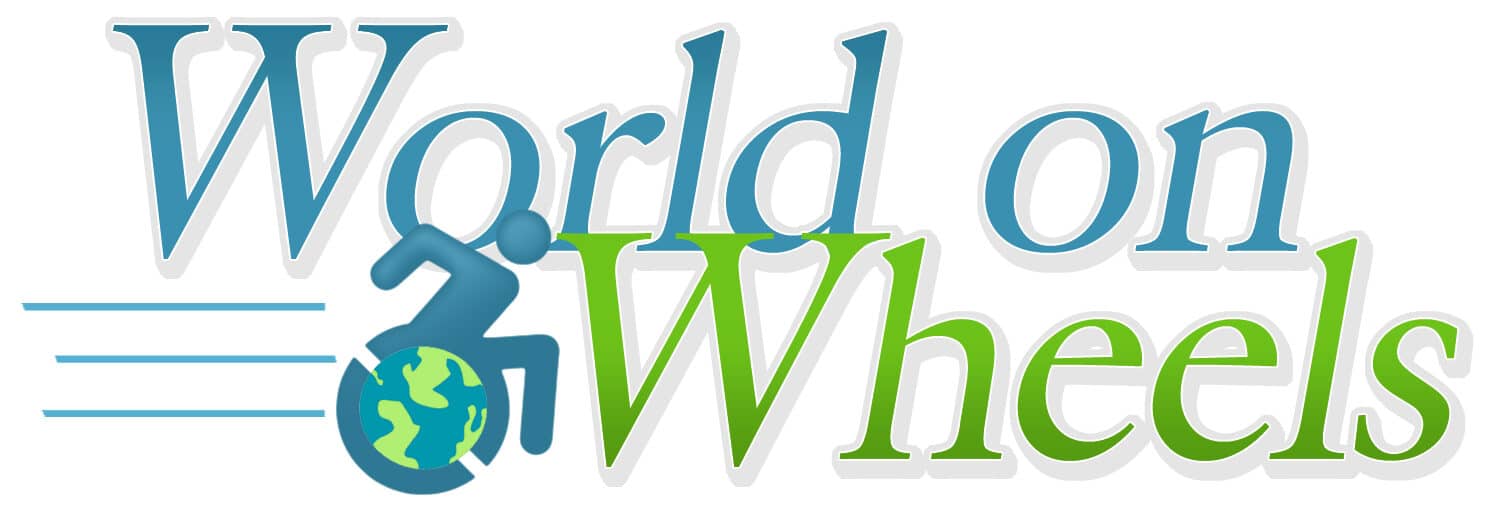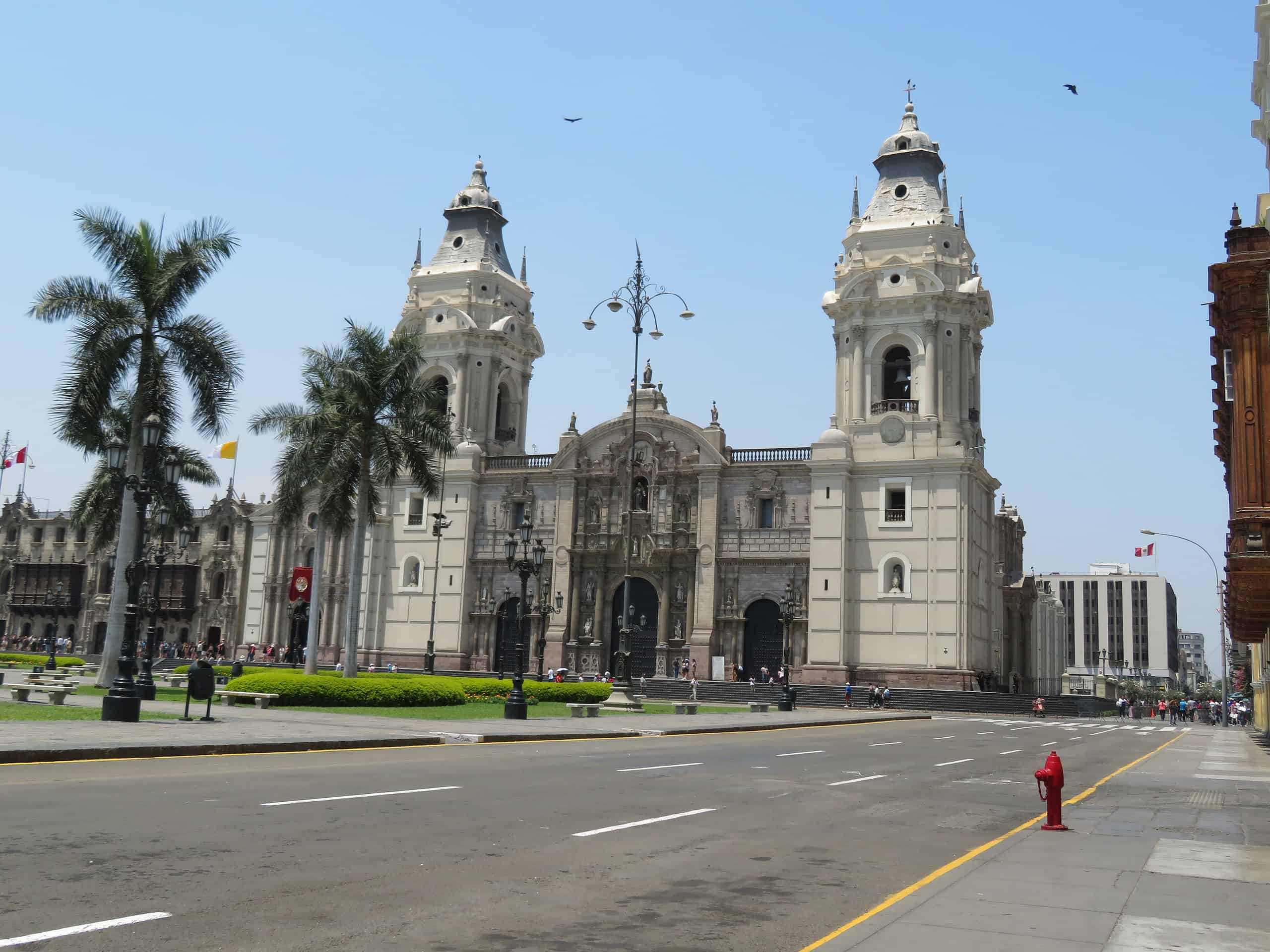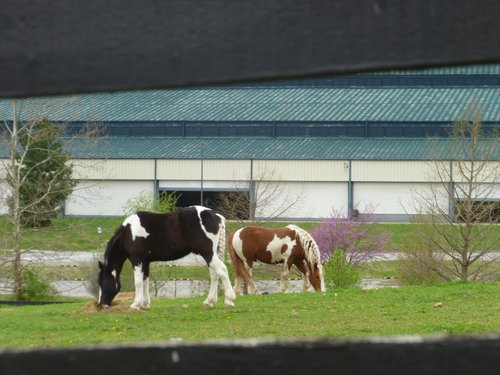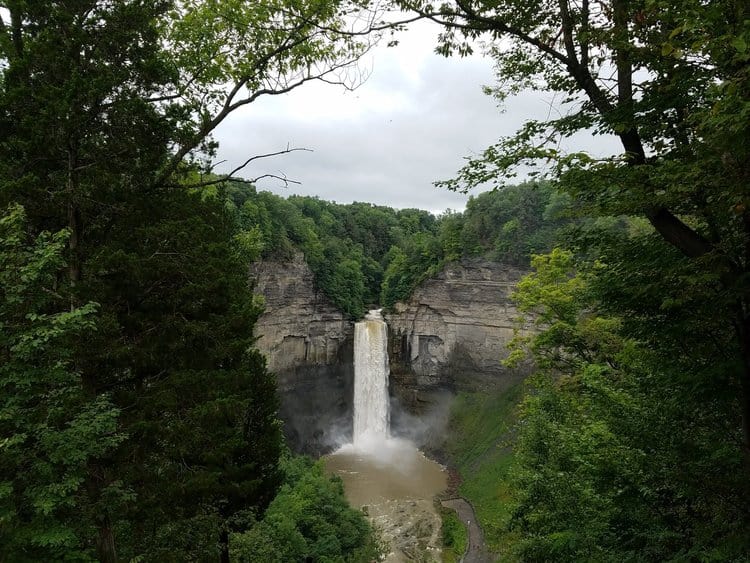The Perfect 8 Day Peru Itinerary for Wheelchair Users and People with Mobility Problems
Peru is one of those iconic destinations on many people’s bucket lists. However, not everyone has the luxury of spending endless amounts of time exploring. So, I’ll give you my 8 day Peru itinerary to help you maximize your time there and give you everything to know if you are visiting with mobility problems.
As someone who travels with a wheelchair, I wasn’t sure if Peru would be the most accessible destination. However, it has been a place I have wanted to visit for a very long time, and was determined to achieve this goal. Now, after visiting this incredible country and seeing popular sights such as Machu Picchu in a wheelchair, I want to share my knowledge with you so you can visit as well.
This post contains affiliate links. As an Amazon Associate, when you click on these links and make a purchase, I earn a small commission at no cost to you.
**Please note that this is NOT a sponsored post. I personally used the services of Accessible Travel Peru but was not compensated in any way for this post. This is my honest opinion and a description of how I spent my time in Peru with them to provide helpful information to others with mobility problems wanting to travel to Peru.**
Is Peru Wheelchair Accessible?
I am not going to lie; Peru has a long way to go to become more inclusive for people with disabilities. However, it is possible to visit Peru with mobility problems and as a wheelchair user thanks to travel companies like Accessible Travel Peru.
Transportation
While Peru has things such as curb cuts in its most popular towns, there are fewer of these features in smaller areas. There is also a lack of accessible public transportation. Lima did have an accessible taxi (which must be prearranged) but none of the other towns had transport for wheelchair users and we had to rely on the adapted vehicle provided by the tour company we used.
Hotels
Additionally, while there are a few accessible hotel rooms available, remember that they will most likely not be what you’re used to in countries that have accessibility laws to guide standards (such as the United States or the United Kingdom). The rooms I stayed in did have grab bars (which were not always located in a place that made them functional) and roll-in showers, but shower seats were not always present and available.
Furthermore, space in the bathrooms was tight and transfers from the wheelchair to the toilet were not always easy. It is best if you are traveling with someone who can assist you.
Sights and Attractions
Likewise, many of the activities I participated in during my time in Peru were only made possible through the use of adaptive wheelchairs and sometimes the brute strength of my trusty guides and assistants that they provided.
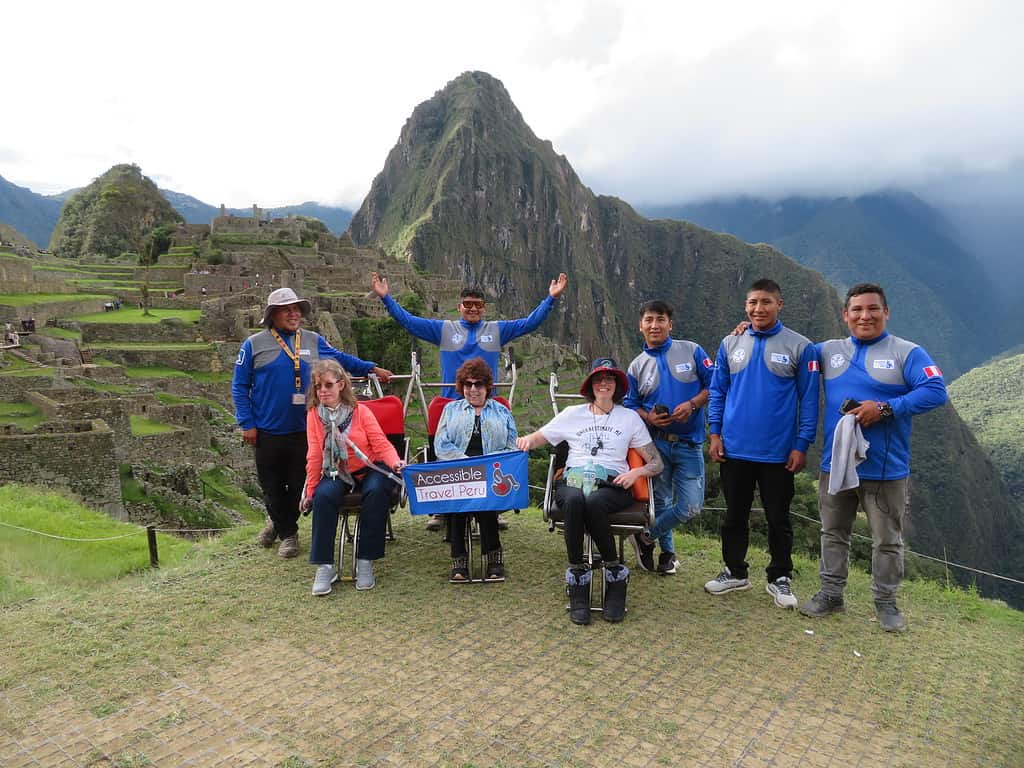
For example, visiting Machu Picchu as a wheelchair user required being carried on buses and trains, as well as the use of a one-wheeled wheelchair which then had to be navigated over stairs and steep terrain.
Is Peru Worth Visiting with Mobility Problems?
Despite everything I described above, I was able to successfully visit Peru as a wheelchair user. Although, I would never attempt a visit here without the guidance and assistance of Accessible Travel Peru whose determination and advocacy are helping make travel to Peru possible for more people.
In short, Peru is worth visiting even as a wheelchair user. Just make sure to bring your sense of adventure and understand the challenges prior to your journey.
Now, let’s get into more detail about how I spent my time there and how you can too.
8 Day Peru Itinerary Overview
- Lima
- Cusco City Tour
- Saqsaywaman and Tambomachay
- Pisaq
- Chinchero
- Ollantaytambo and Machu Picchu
- Drive to Puno
- Lake Titicaca (Uros and Tequile Islands)
8 Day Peru Itinerary for Wheelchair Users
This itinerary is based on travelers having 8 full days in Peru and does not include international travel time. It was designed for first-time visitors to Peru along with people with mobility problems. Additionally, it is the exact itinerary I followed for my trip to Peru and includes personal photos along with firsthand experience.
Day 1: Lima
City Driving Tour
Today starts with a driving tour of the city. We passed a lovely park by the ocean, historic churches, and even a pyramid. I never would’ve expected to see a pyramid in Lima Peru. This pyramid was used for sacrifices to ensure fertility.
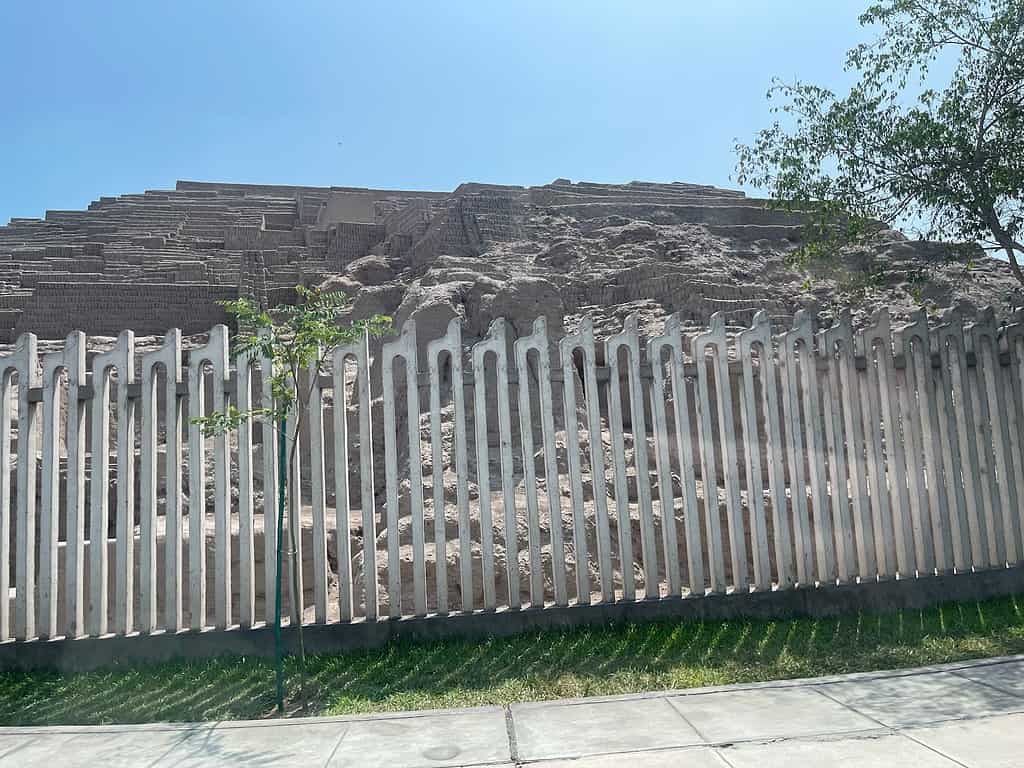
After the guided driving tour (trust me a guide and driver are worth it because the traffic and driving in Peru is crazy), head over to the pedestrian area of the city. There are plenty of cafes and restaurants where you can try some local dishes.
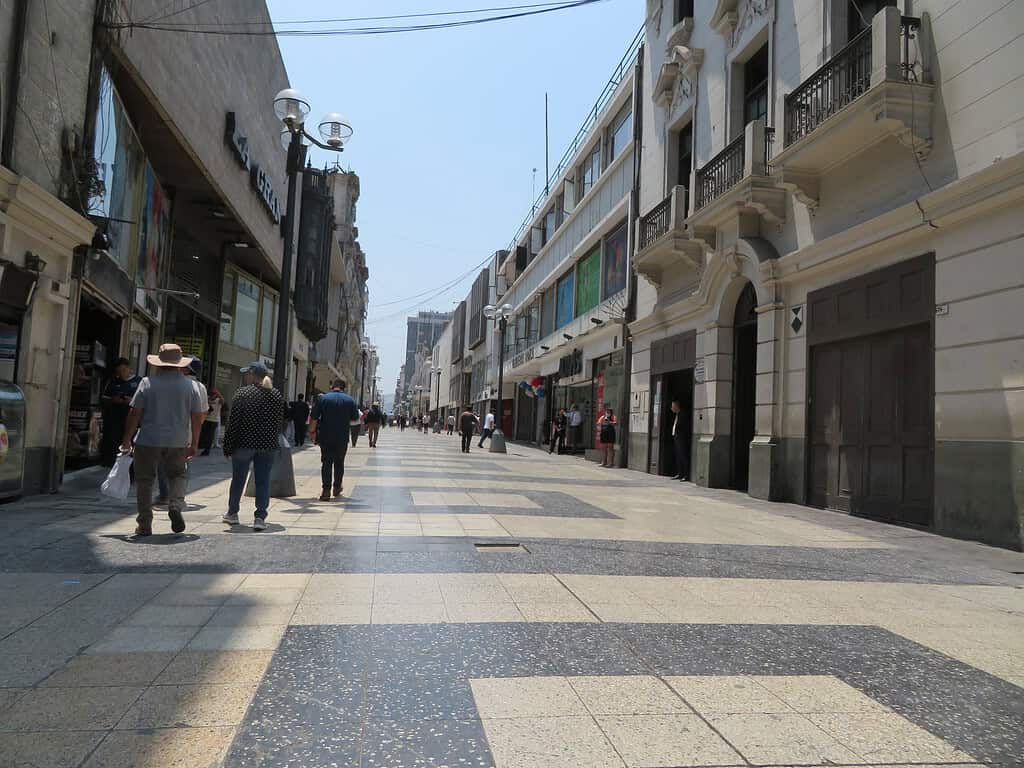
There are plenty of shops as well, but if you want authentic and local souvenirs then wait to buy them in Cusco or Puno.
Main Square
After lunch, head to the main square for photos of the iconic buildings in Lima. The Spanish-style architecture is beautiful and makes for a fantastic backdrop.
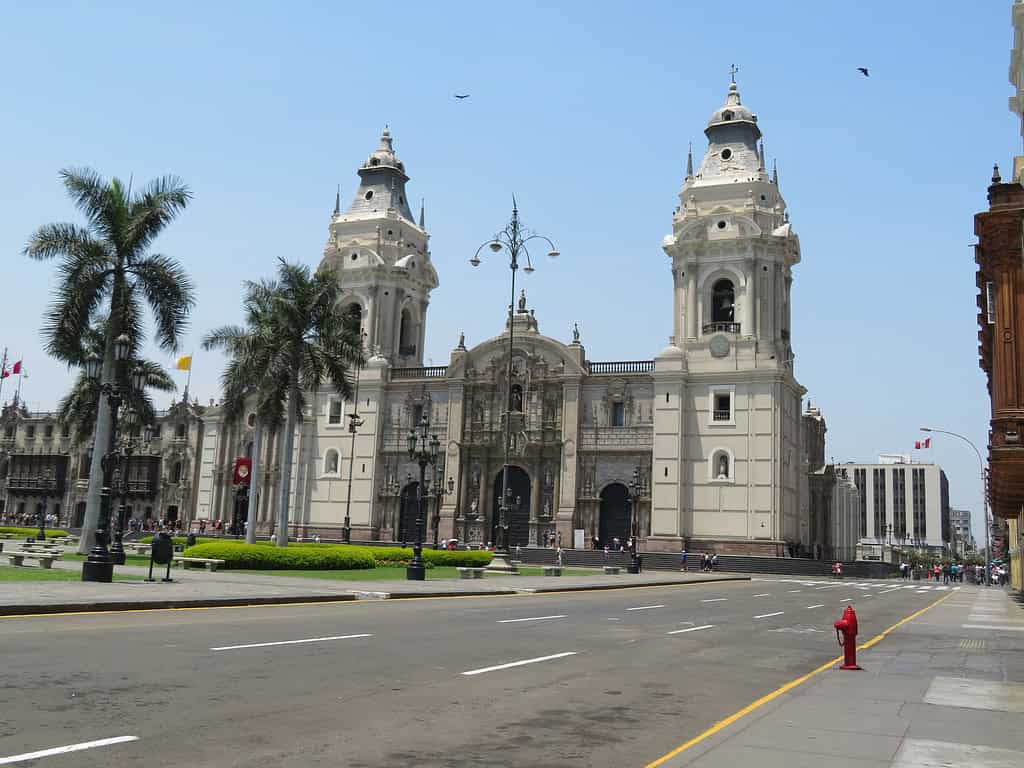
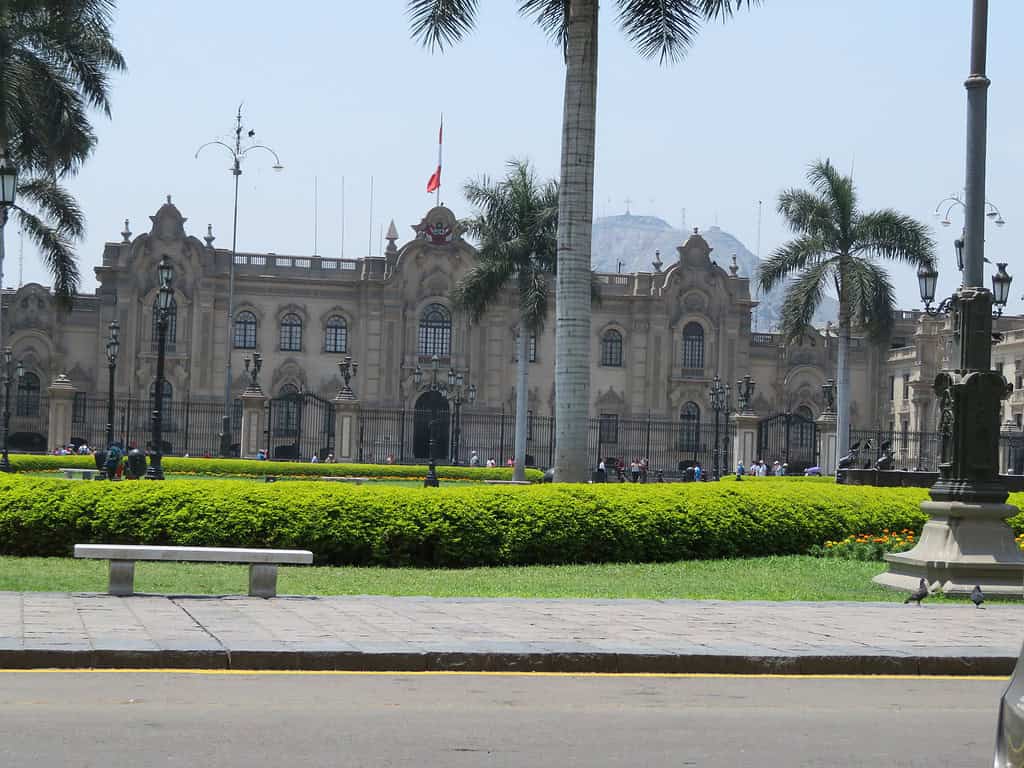
Sidewalks and surfaces are flat and mostly smooth. There will be some bricked areas or places with cobblestones that may be bumpy. However, most of these sections can be avoided.
Basilica y Monasterio de Santo Domingo
Then head down the street for a visit to the Basilica y Monasterio de Santo Domingo. Here you will find beautiful tile work, chapels dedicated to Peruvian Saints, and a historic library that holds the oldest books and manuscripts used by the Dominicans.
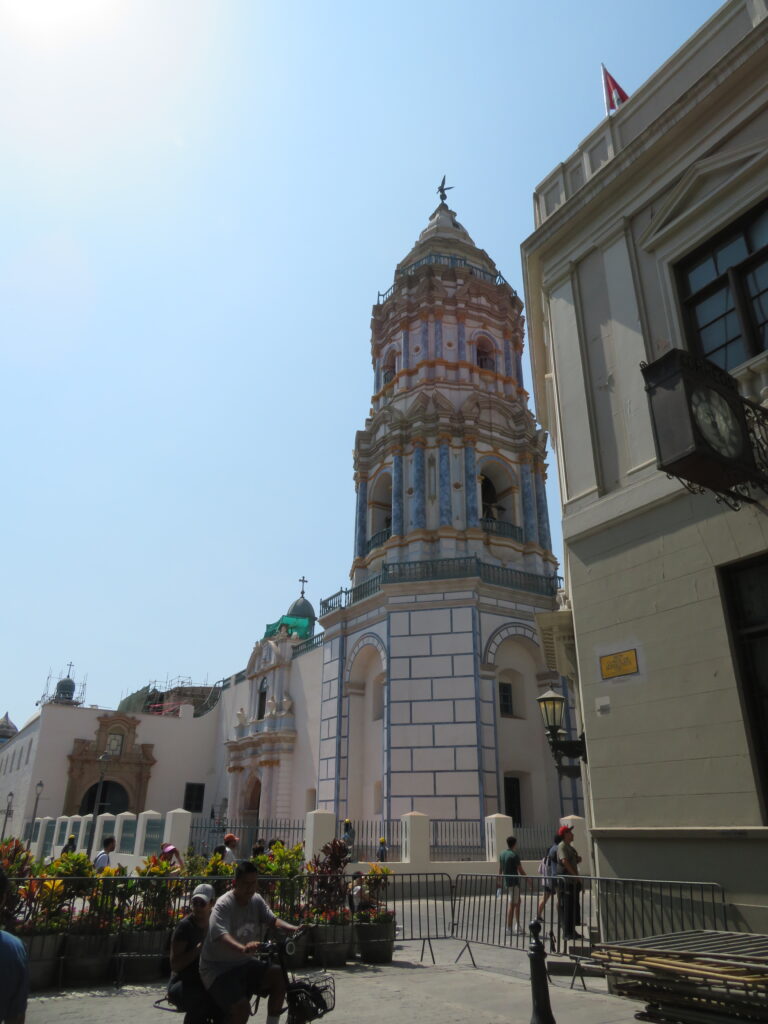
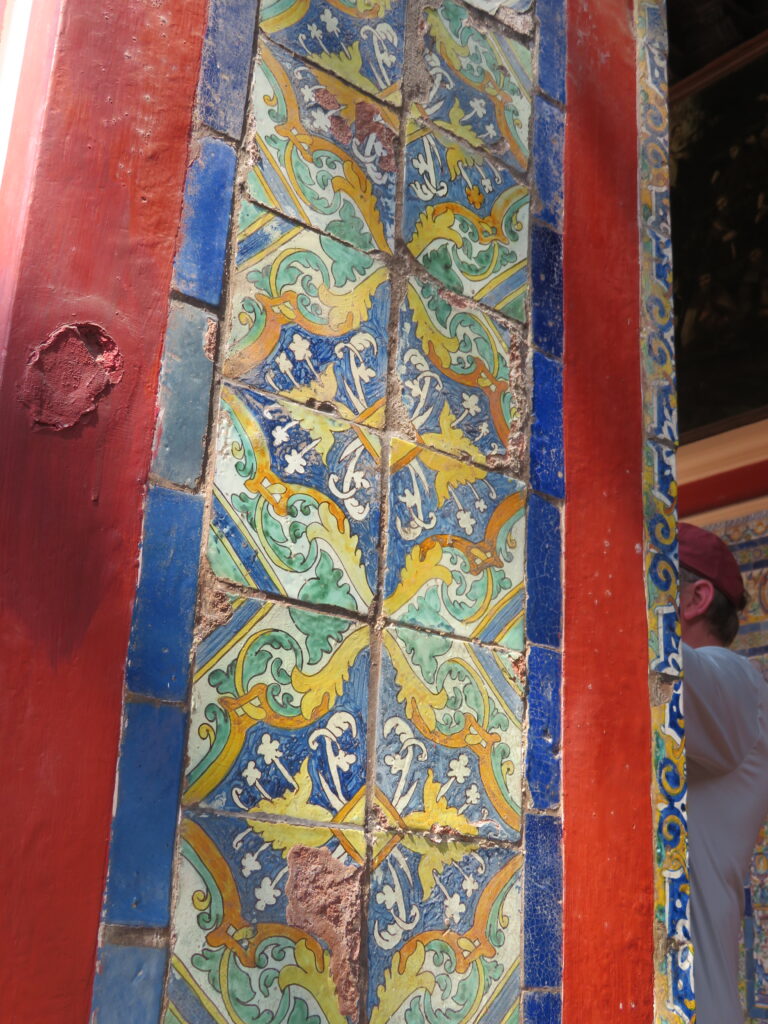
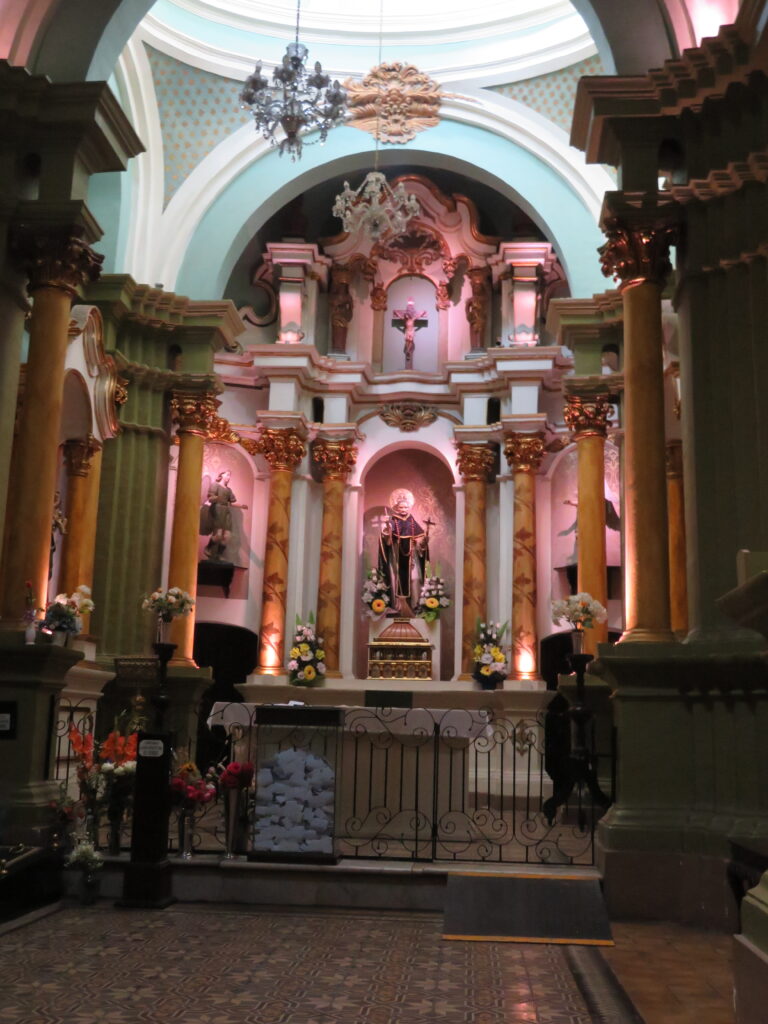
When I visited, they were also preparing the floats for the Easter parade that is held every year. Each float depicts a saint and is adorned with flowers.
While the accessible entrance was under construction when I visited, I was still able to explore as helpful staff carried me in my wheelchair down the 5 stairs in the alternative entrance. Once inside, there were ramps throughout to allow me to see the chapels and other highlights.
Larco Museum
End your day with a visit to the Larco Museum which is a private collection (open to the public) of Incan artifacts. During your visit, you will see hundreds of pieces of pottery, elaborate Incan gold and silver jewelry, and other pieces of art.
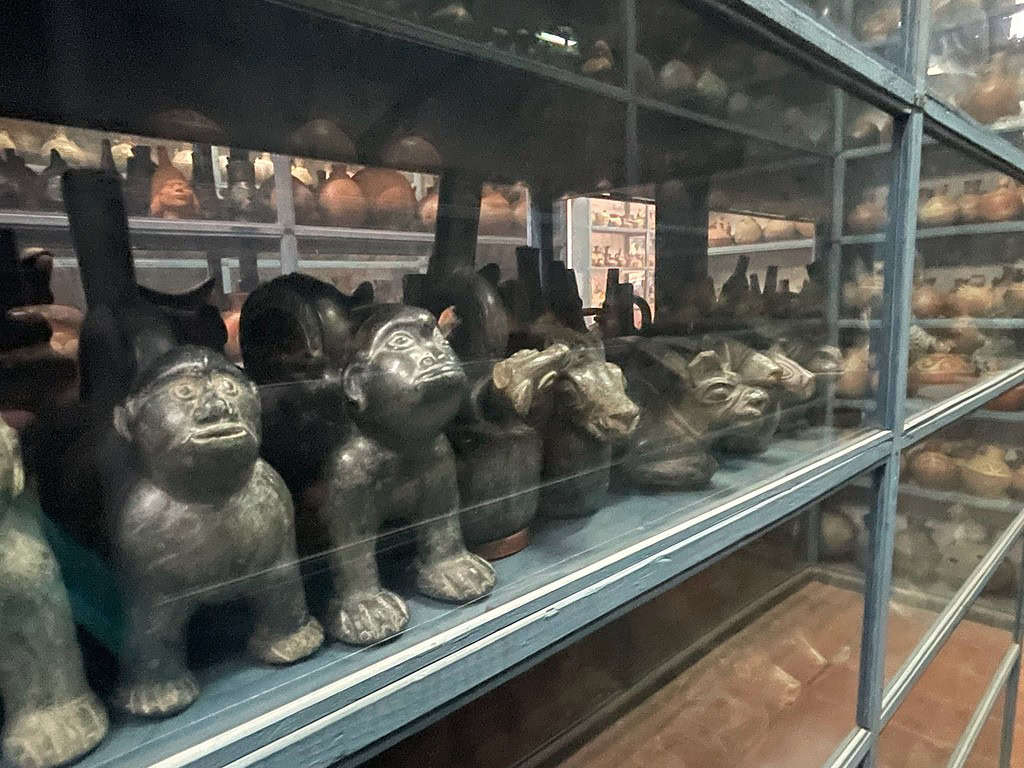
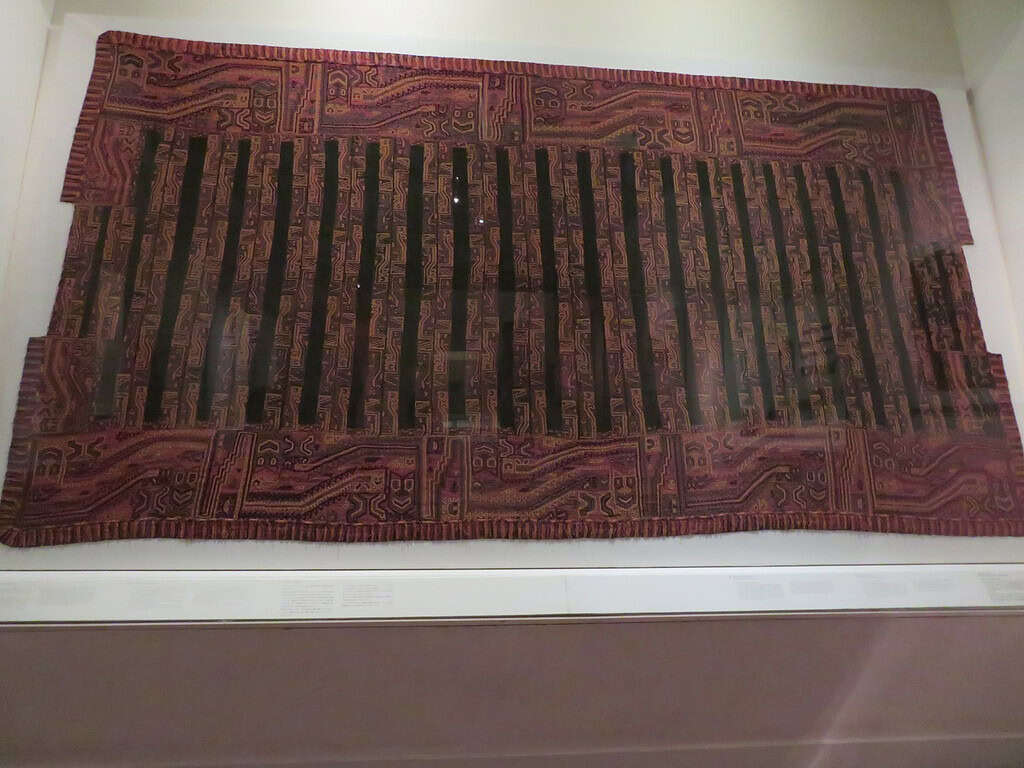
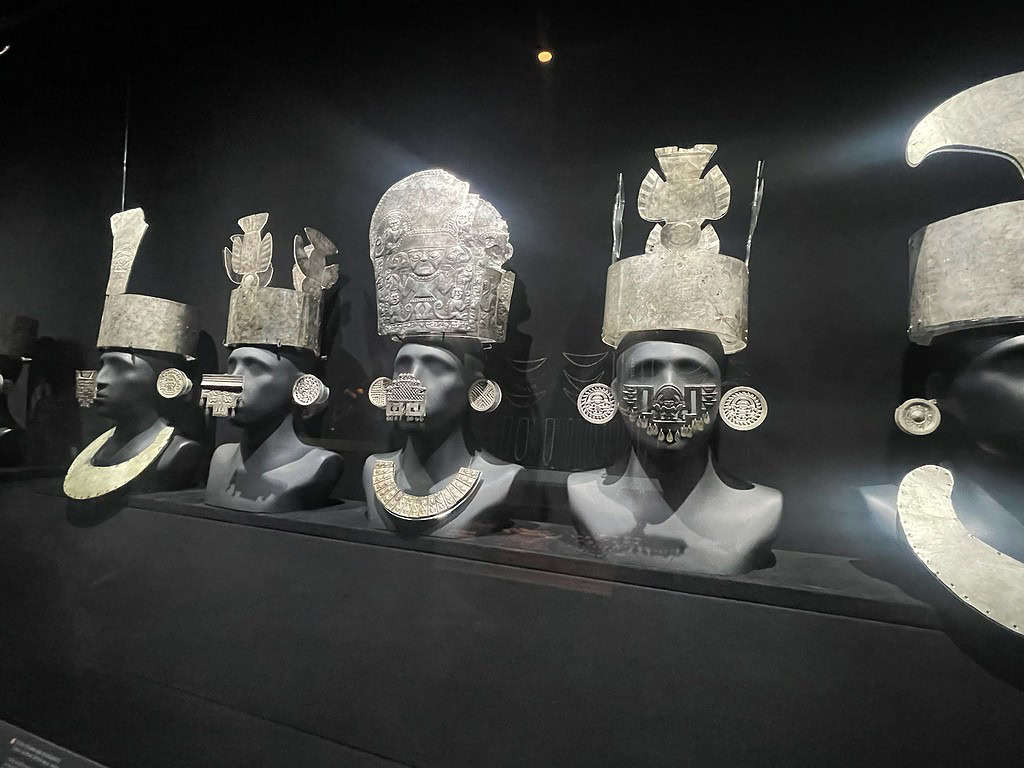
There is also an onsite restaurant if you’d like to have dinner here.
There are some steep ramps to enter the museum but attendants are on hand to assist you. Inside the pottery building, passages are narrow and can lead to dead ends, so be mindful as you explore.
On the other hand, the other buildings are more open and easier to roll around in a wheelchair. There are also benches throughout if you want to sit to rest or admire the artwork in more detail.
Day 2: Lima to Cusco and Cusco City Tour
After breakfast, head back to the airport for your flight from Lima to Cusco. Book a late morning flight to allow for time spent in traffic and so you have the afternoon to explore Cusco.
On arrival, drop off your bags at the hotel and take a little rest to help acclimate to the higher altitude. Lunch is available at the hotel in most cases.
Cusco City Tour
Your city tour starts at Convento de Santo Domingo which was built over ancient Incan Temples (some of the ruins can still be seen inside). Now this building is part church, part museum and you can walk around exploring temple ruins and pieces of Incan art. There is also a beautiful view of the city of Cusco.
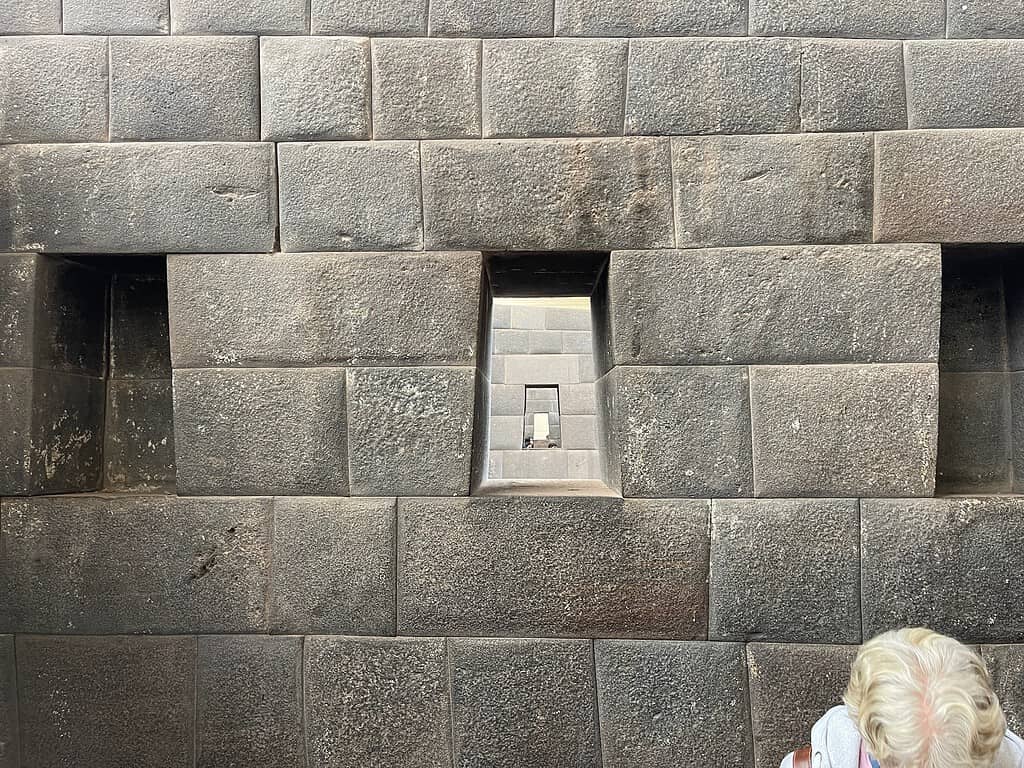
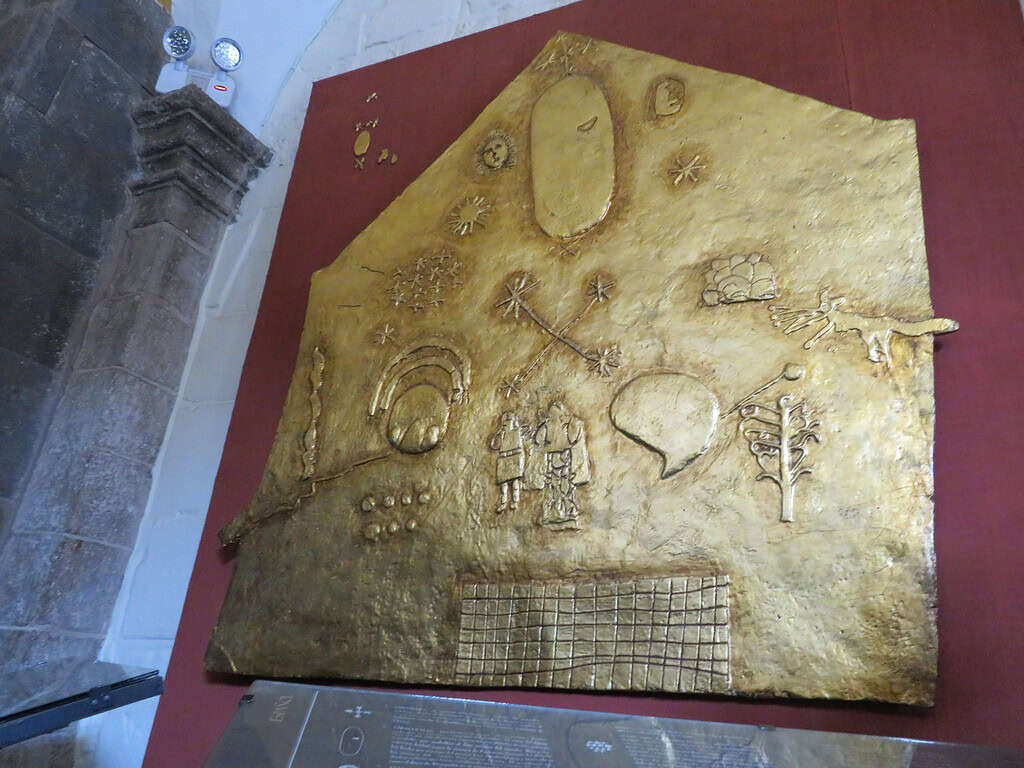
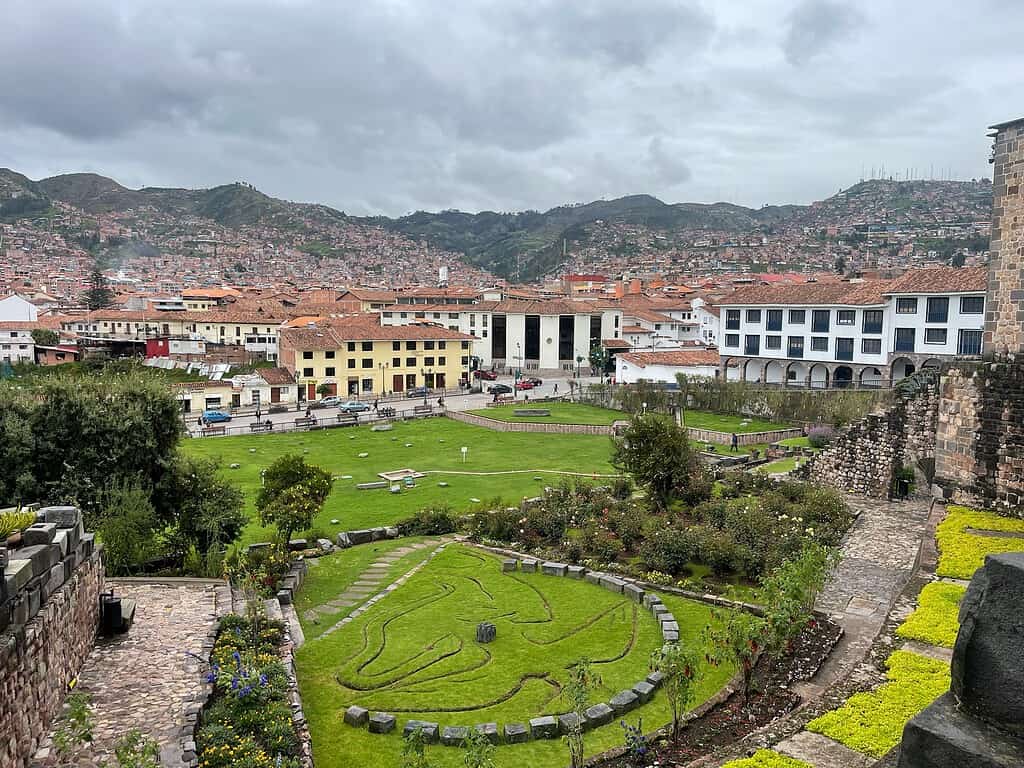
Stone floors and surfaces make for uneven surfaces. There are small ramps available to most areas making it mostly accessible. Although there are some areas where assistance may be needed when your front wheels get caught on the floor.
Afterward, you’ll make your way to the main city square to see two different churches and a fountain dedicated to the Incan King Pachacuty who is responsible for creating Machu Picchu.
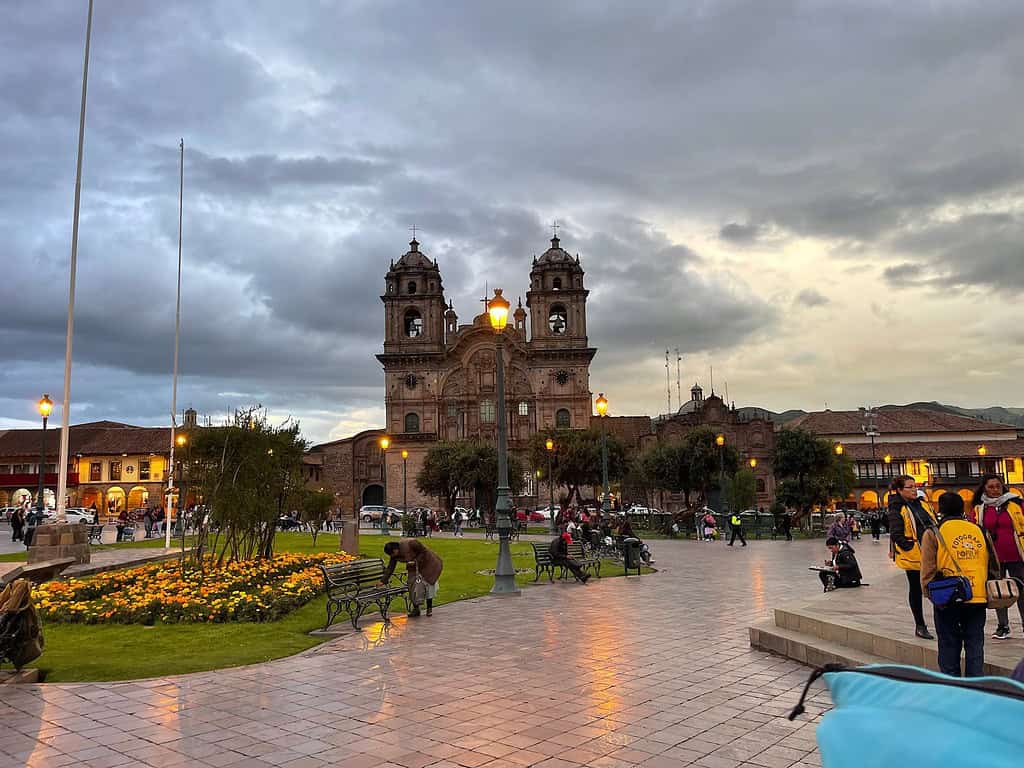
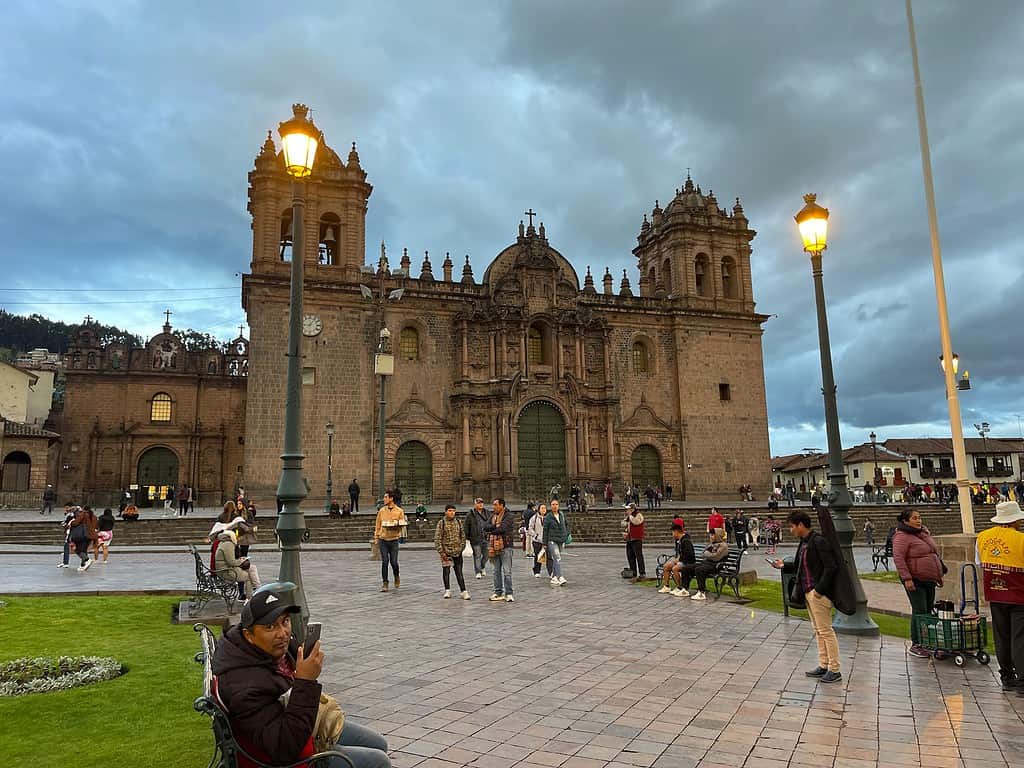
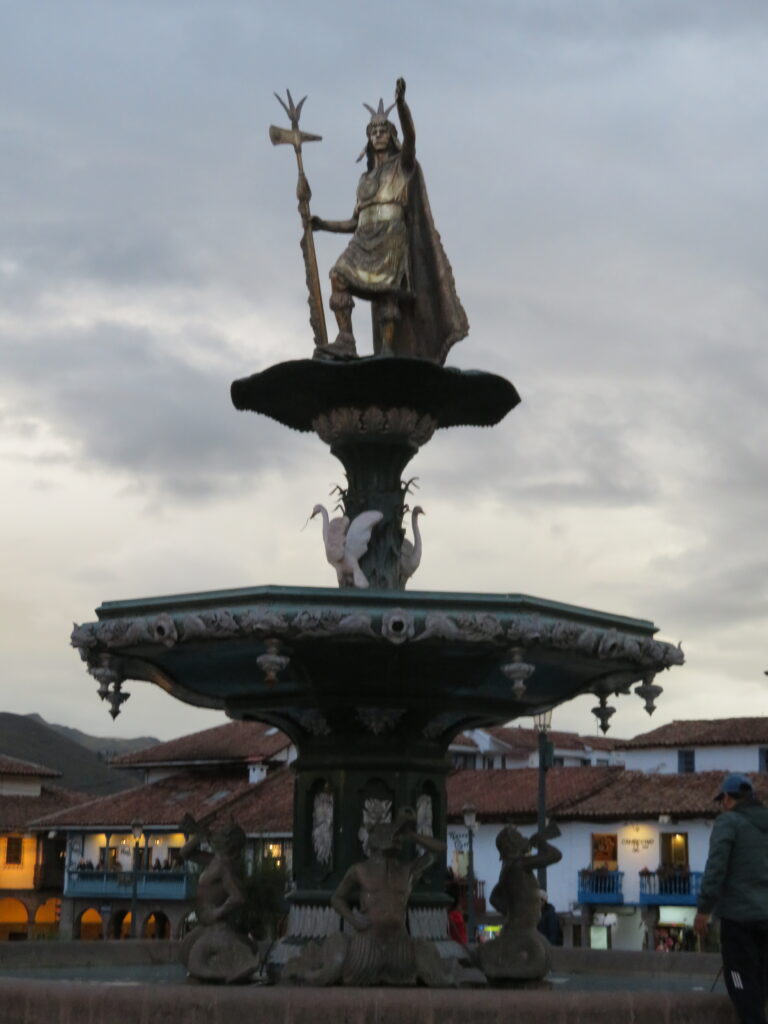
Several restaurants are around the square and make for an excellent place to try local cuisine such as guinea pig. Don’t worry though, there are plenty of other options if you want something else.
Get a restful sleep tonight to help your body adjust to the higher elevation. Tomorrow will involve more exploration of ancient Incan sites.
Day 3: Saqsaywaman and Tambomachay
Cusco is a fantastic base for exploring the Sacred Valley which includes other Incan sites other than Machu Picchu. Today you will get your first glimpse of some of the amazing Inca architecture and ruins.
Actually, there are so many sites that there is a Cusco Tourist Ticket you can purchase that will get you entry into all of them. Just present the Tourist Ticket and for each of the places you visit, you will receive a hole punch. It’s also a great way to keep track of the names of these places.
➡️ Check prices and options for your Cusco Tourist Ticket by clicking here.
Tambomachay
While there is some debate regarding the purpose of this site, what is agreed upon is that it shows off Incan engineering and focuses on the importance of water. Visitors will see small waterfalls emerging from terraced stone walls.
In fact, one of the theories as to the purpose of this place is that it was used as a bathing site while also providing water to nearby areas.
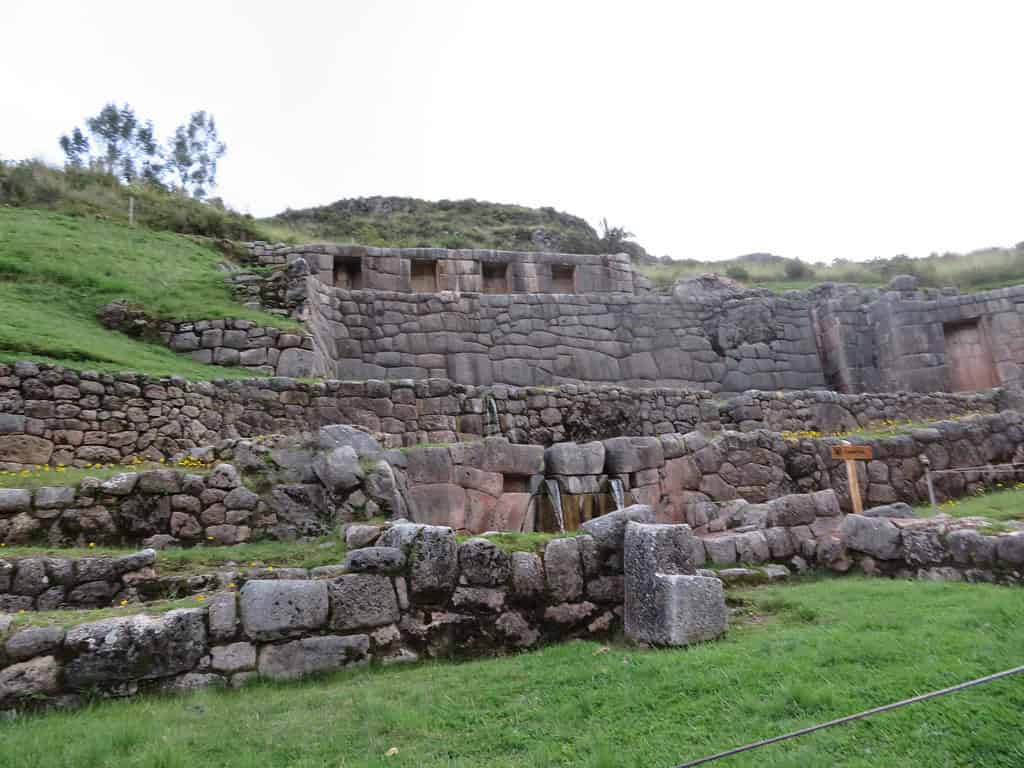
The path to get to the main area of Tambomachay is uneven and on an incline despite portions starting out paved in the beginning. Manual wheelchair users may need some assistance to navigate it.
The path also passes a field where you may spot alpacas and sheep. When I visited, there were locals dressed in traditional clothing holding a lamb and asking for money for photos.
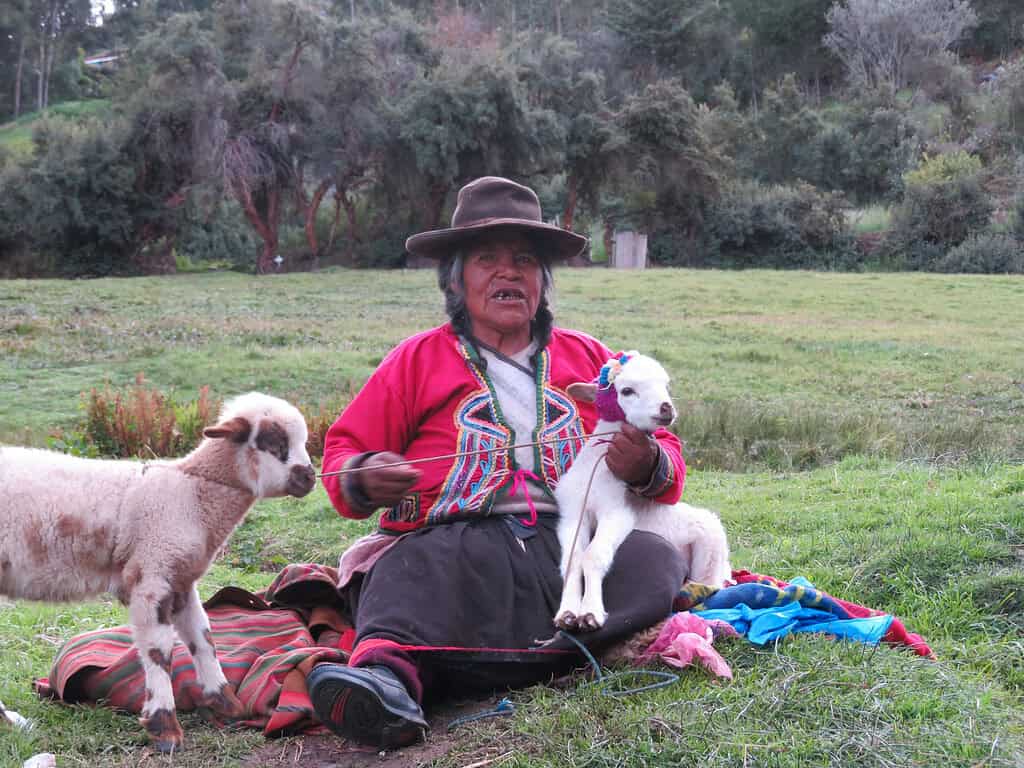
One of my Peru travel tips is to always ask before snapping pictures of people, it’s the polite thing to do. Additionally, many will expect some form of payment in exchange.
Saqsaywaman
Often thought of as a fortress, this site is imposing and impressive. Large stone bolders weighing anywhere from 90-125 tons each are intricately placed (without the use of mortar) and have stood the test the time. They’ve even survived local earthquakes, which highlights the excellence of Incan architecture.
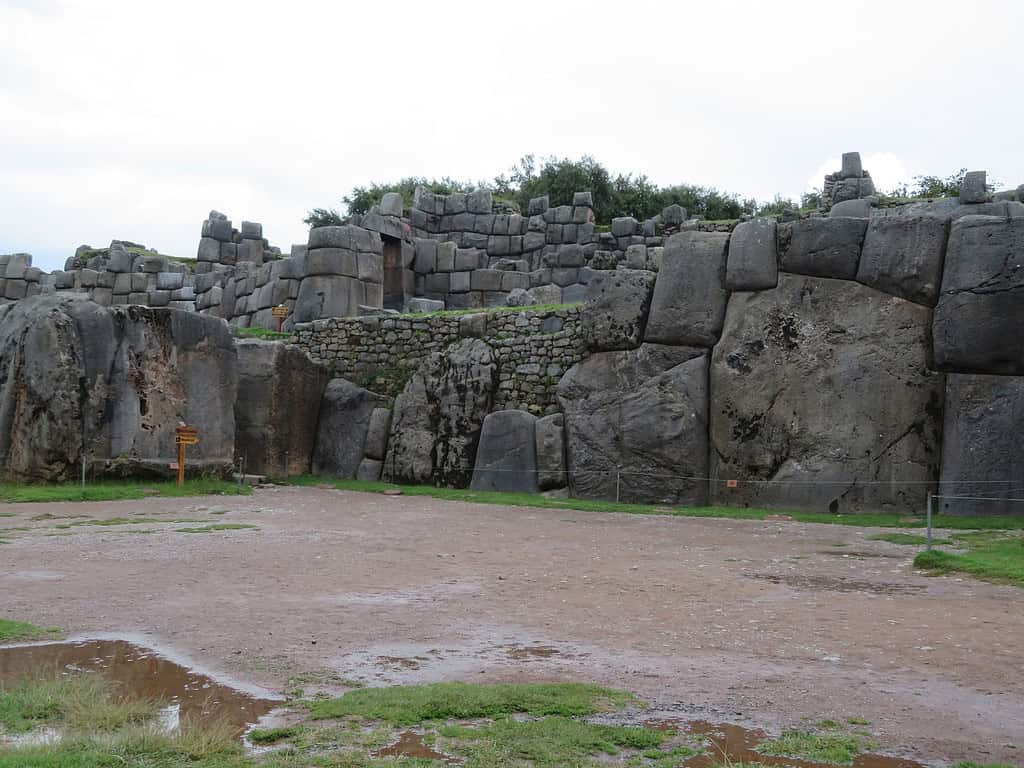
From the parking area, there is a grassy and dirt path to reach the main area of the site. It is uneven and has inclines (some steep) to manage. As a result, the accessible travel company had us use adapted wheelchairs.
These wheelchairs have one wheel and metal rods coming out of the front of the chair. Two people (one in front and one in back) then balance and navigate the chair over the rough terrain.
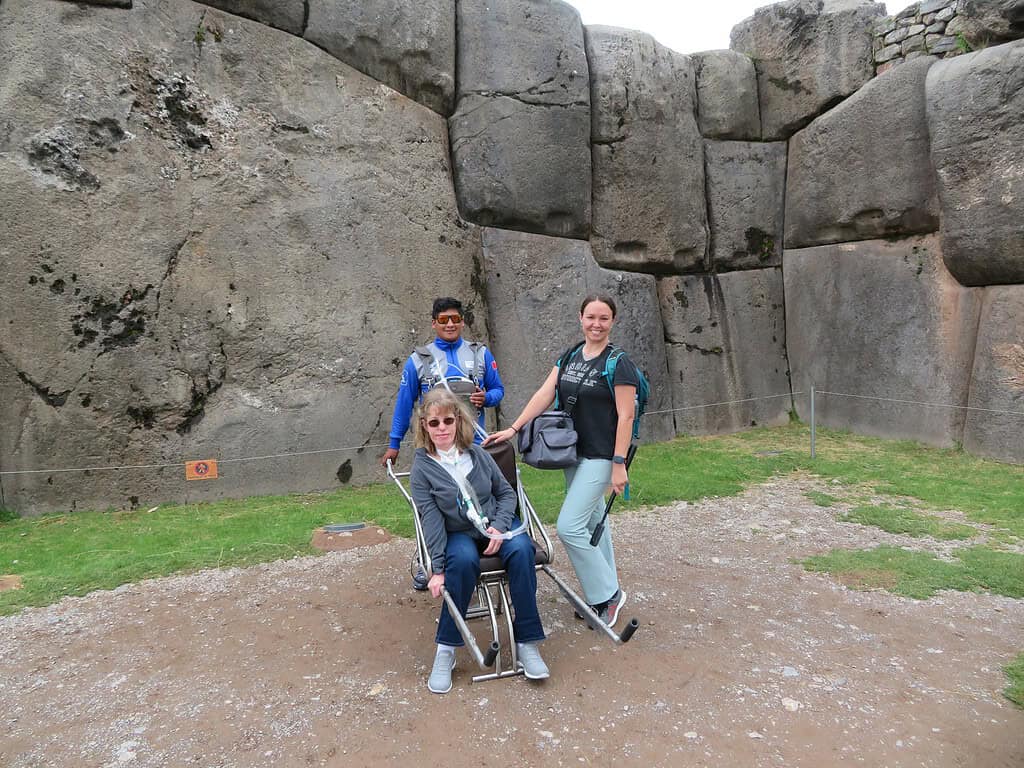
We would come to rely on these specialized chairs several times during the trip and they were only available through the tour company.
Day 4: Sacred Valley: Pisaq and Ollantaytambo
Today head further into the Sacred Valley to visit two more awe-inspiring sites. Allow for a drive time of 1-2 hours to get there from Cusco.
Pisaq
Located on the top of a mountain, this former Inca village has impressive ruins that will give you a sense of what life was like hundreds of years ago.
There’s a small parking area with roadside shops set up before you enter the site. An uneven and dirt path will guide you through watch towers until you get to the main living area of the community. Some stairs are also along the way so the adapted wheelchairs were used.
As you enter the main living area, the mountain views are impressive. Although it rained the day I was there and there was fog, what I could see still gave you the impression of how grand the view must be on a clear day.
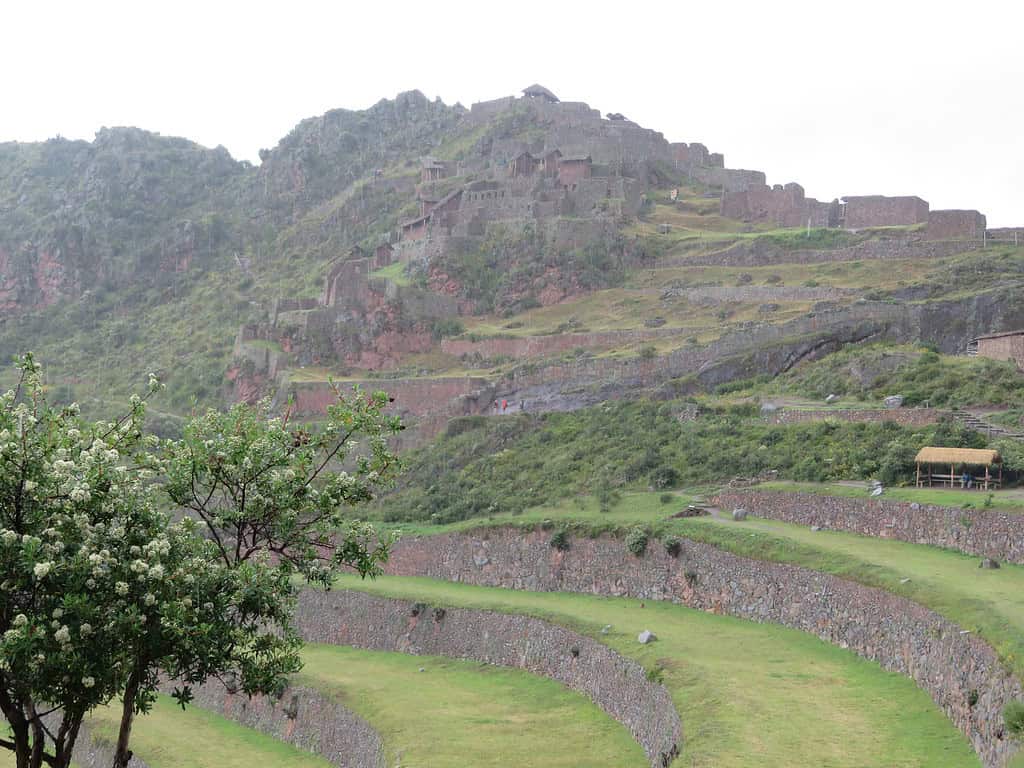
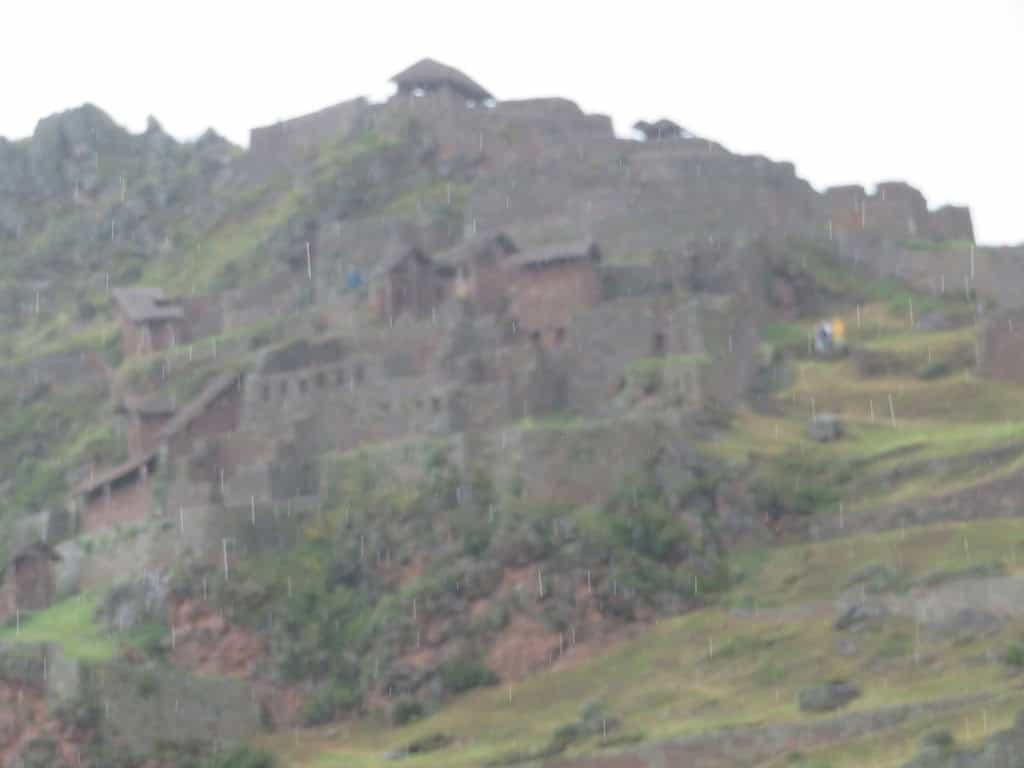
As llamas grazed, the guide told me about what life was like in the village. He also pointed out the holes found in the side of the mountain which are actually graves of the deceased that had been robbed.
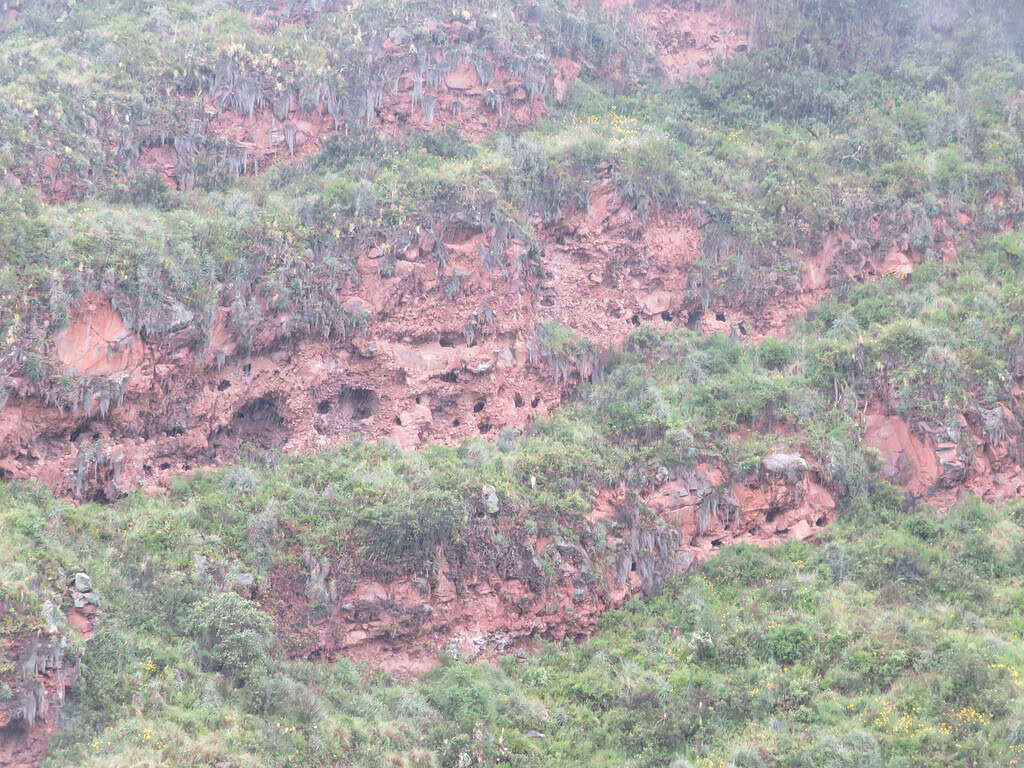
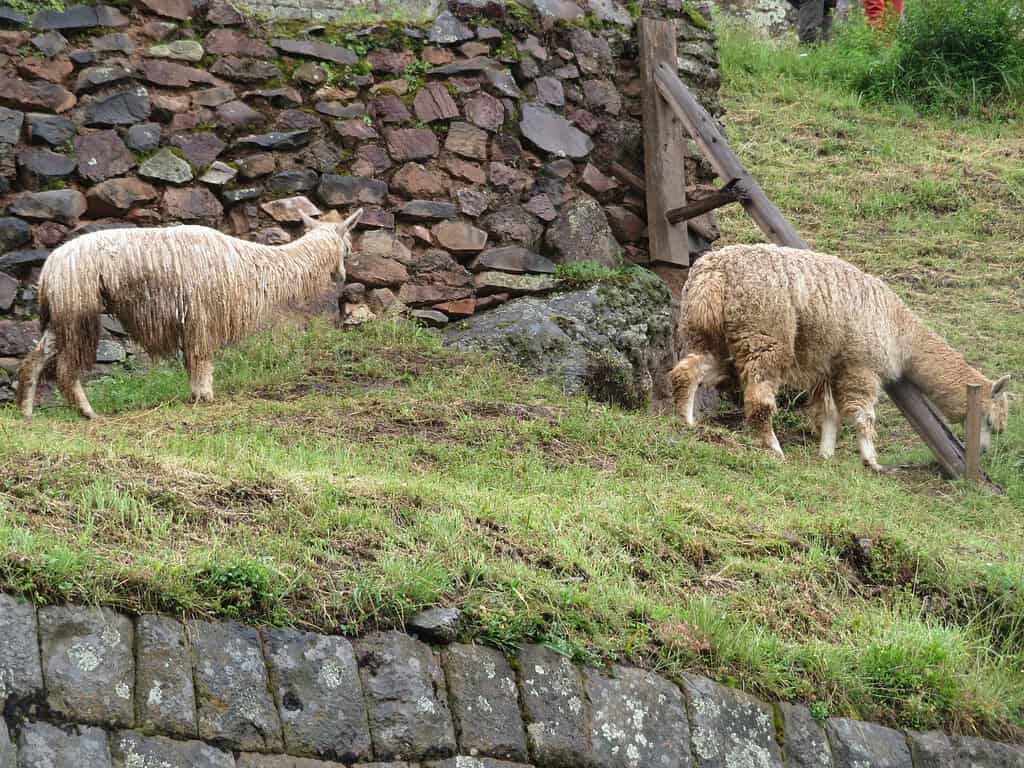
Silver Shopping
After descending the mountain and into town, make sure to stop and check out some of the purest silver in the world (95% silver). The shop I stopped at showed us how to tell real silver from fake varieties as well as the meaning and purpose of certain stones.
While I don’t typically buy a lot of souvenirs, I did pick up some beautiful earrings made from Serpentine and Silver.
Ollantaytambo
Near the train station that will take you to close to Machu Picchu, lies another Incan site which is nestled between the jungle and the valley. It was a place where people came to cleanse themselves spiritually before transitioning from one environment to the other.
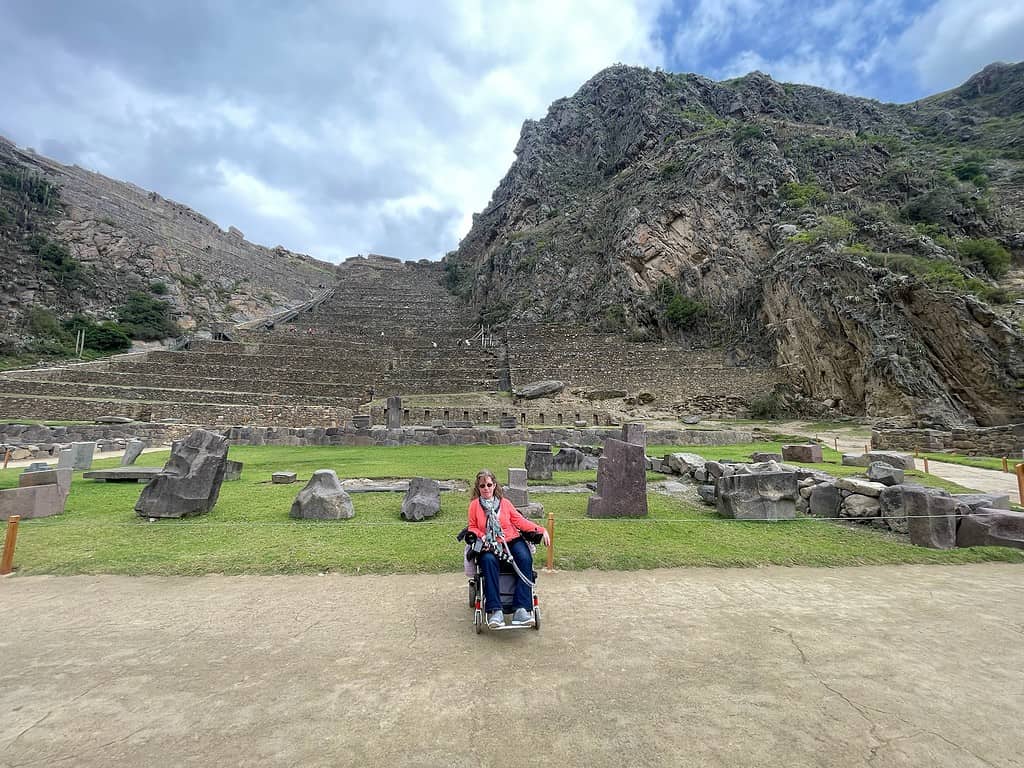
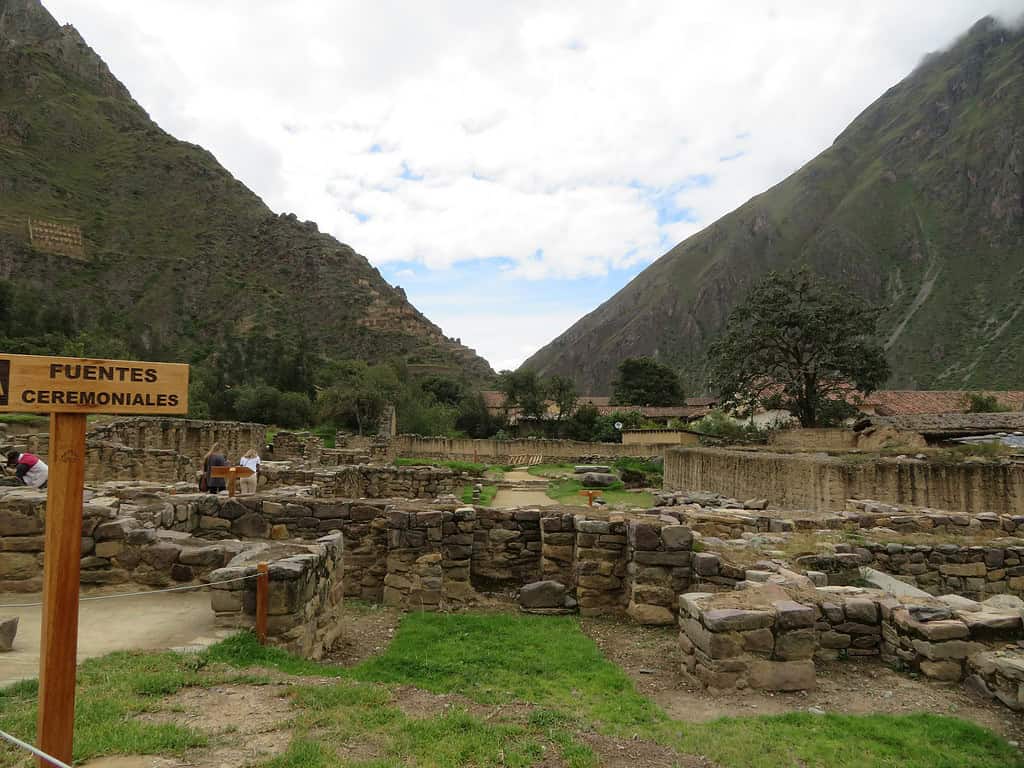
It is also home to a legend.
The ground is very uneven so wheelchair users will need some assistance. Ramps allow entrance to the bottom portion of the site. However, MANY stairs are required to reach the upper portion where the Temple of the Sun is.
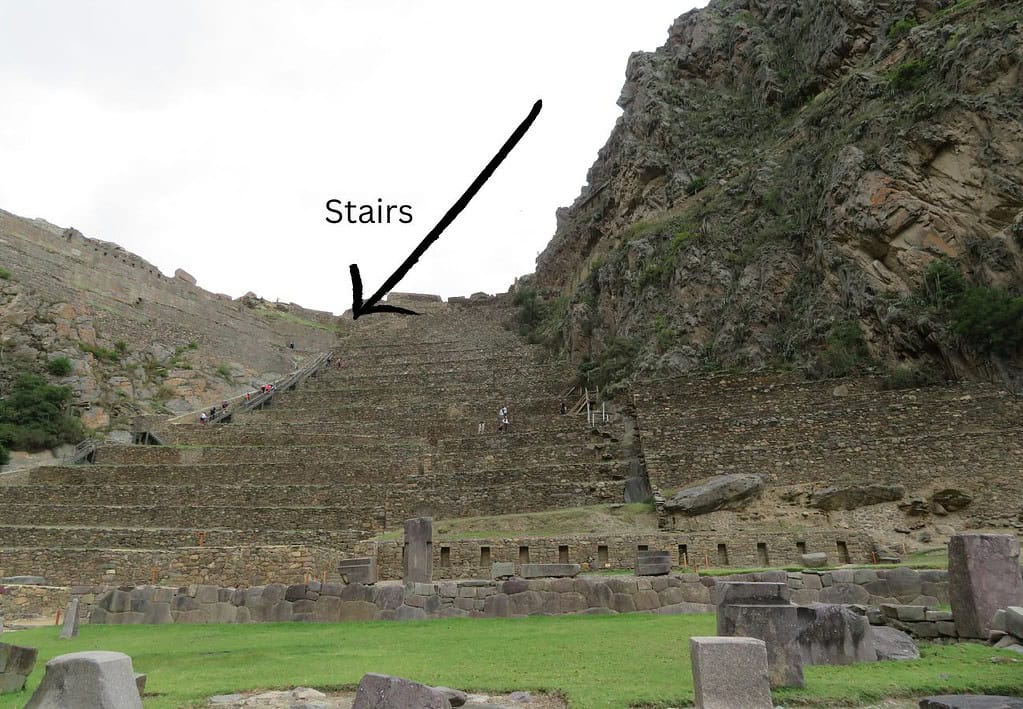
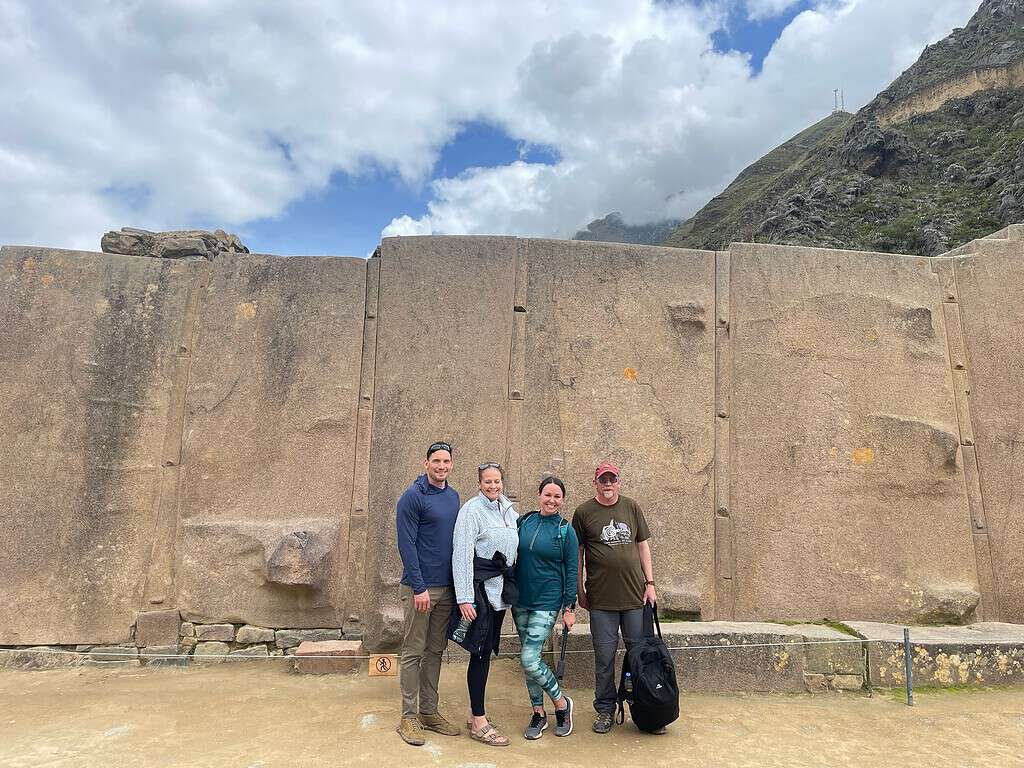
Despite limited access, I still enjoyed marveling at the engineering, seeing alpacas, and learning more about the incredible history of this site.
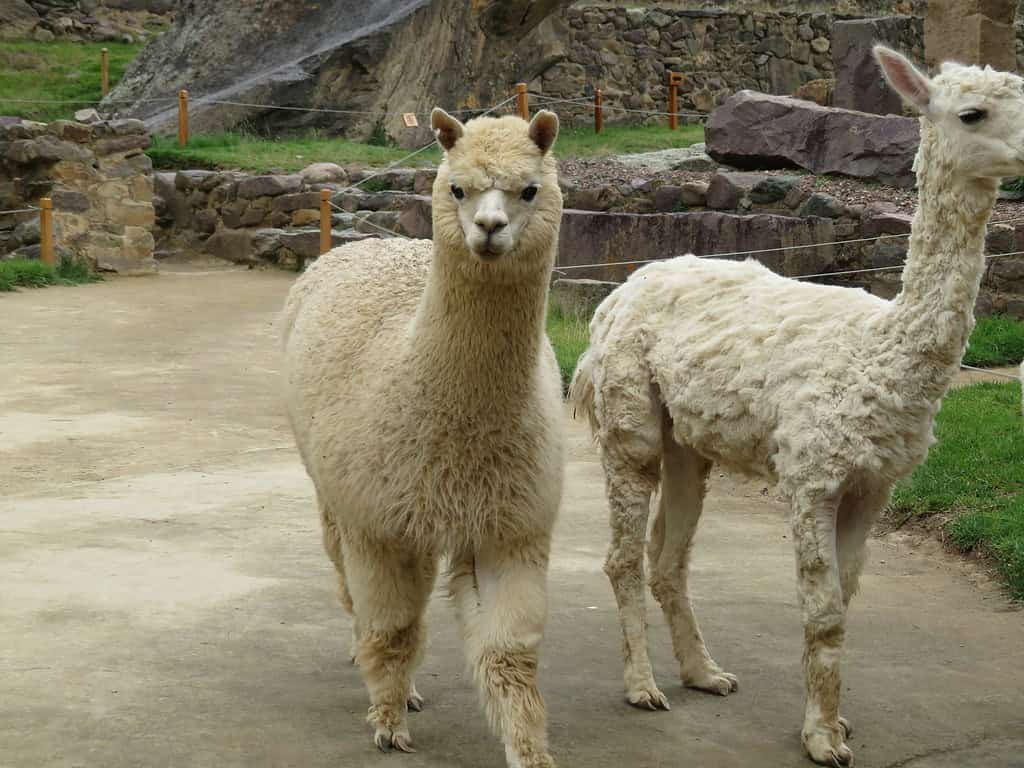
Day 5: Chinchero
Chinchero is a small village high in the mountains and somewhat secluded from the usual tourist stops. However, near this town is a local community that is beginning to allow visitors to learn more about the local way of life.
The wheelchair-accessible small group tour I was on was welcomed by a local family that lived near a lake. The women taught us about how they take wool and turn it into yarn, dye it, and then weave it.
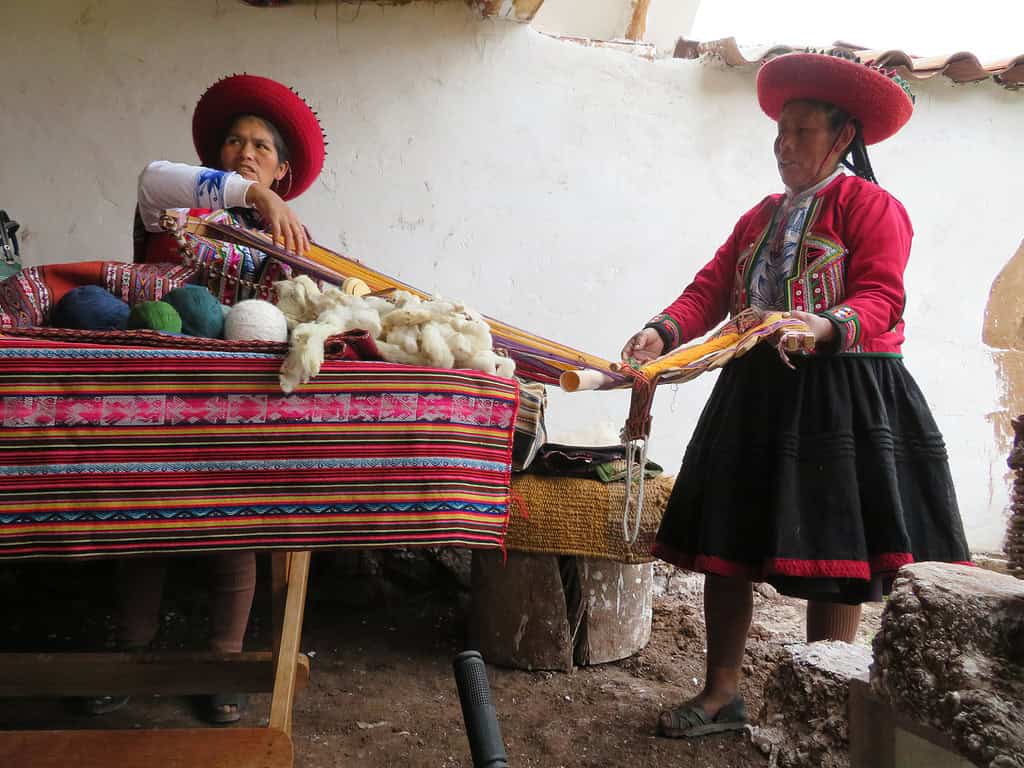
Then the man of the house taught us about the local agriculture. Did you know that Peru has over 5,000 different types of potatoes??
We then learned how the fresh produce is preserved so that it lasts year-round. It was very interesting.
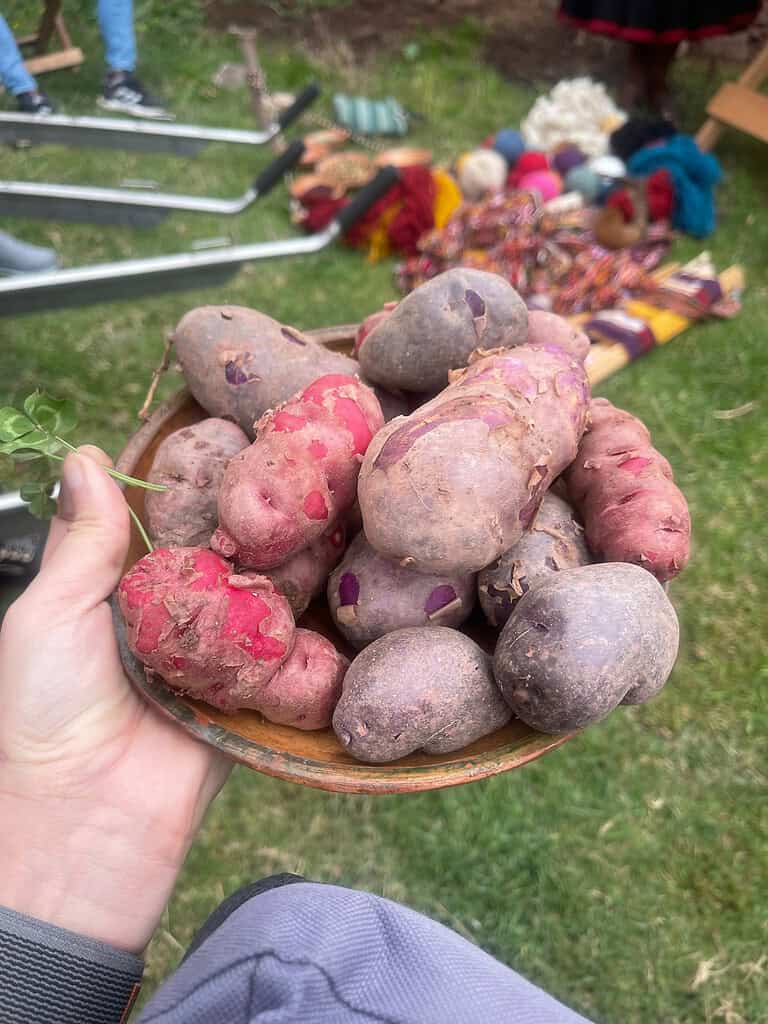
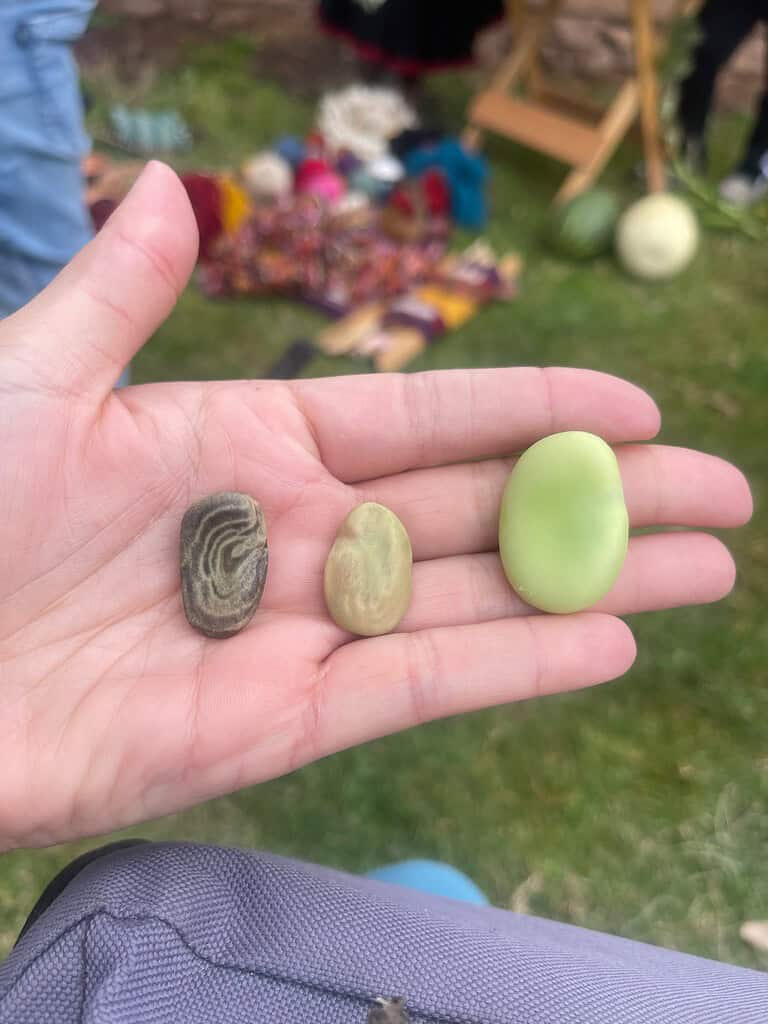
At the end, we were invited to wear local clothing to understand how it feels. Of course, the family wanted to take photos with us as well.

To end this fabulous day, we enjoyed a home-cooked meal with the family. The food consisted of chicken, guinea pig, three different types of cooked potatoes, quinoa soup, pasta, and other vegetables. It was delicious. And, yes, I tried the guinea pig.
I don’t know that you would be able to do this by using public transportation. So, I recommend using a tour and guide to assist you.
Furthermore, the community didn’t speak Spanish but rather Quechua which is closer to the language that the Inca spoke.
Additionally, the path to the house was very uneven and required the use of adapted wheelchairs.
Day 6: Machu Picchu
Today is the day that you will surely be looking forward to as it is the day you will travel to the iconic Machu Picchu! It is a LONG day trip from Cusco but 100% worth it.
While there is a town closer to the site, it unfortunately is not very accessible, and not recommended to stay there if you have mobility problems or are a wheelchair user.
Getting There
To start, you will need to drive (or have your driver drive you) to the train station which is about 1 hour and 40 minutes away (depending on traffic). Next, you will board the train and travel another 2 hours to the town of Aguas Calientes.
The train ride is very scenic and there is even a little performance onboard which tells the tale of a local legend.
Once at Aguas Calientes. You’ll have to make your way to the main street and board a bus which will take you the rest of the way to the entrance of Machu Picchu (about 30 minutes).
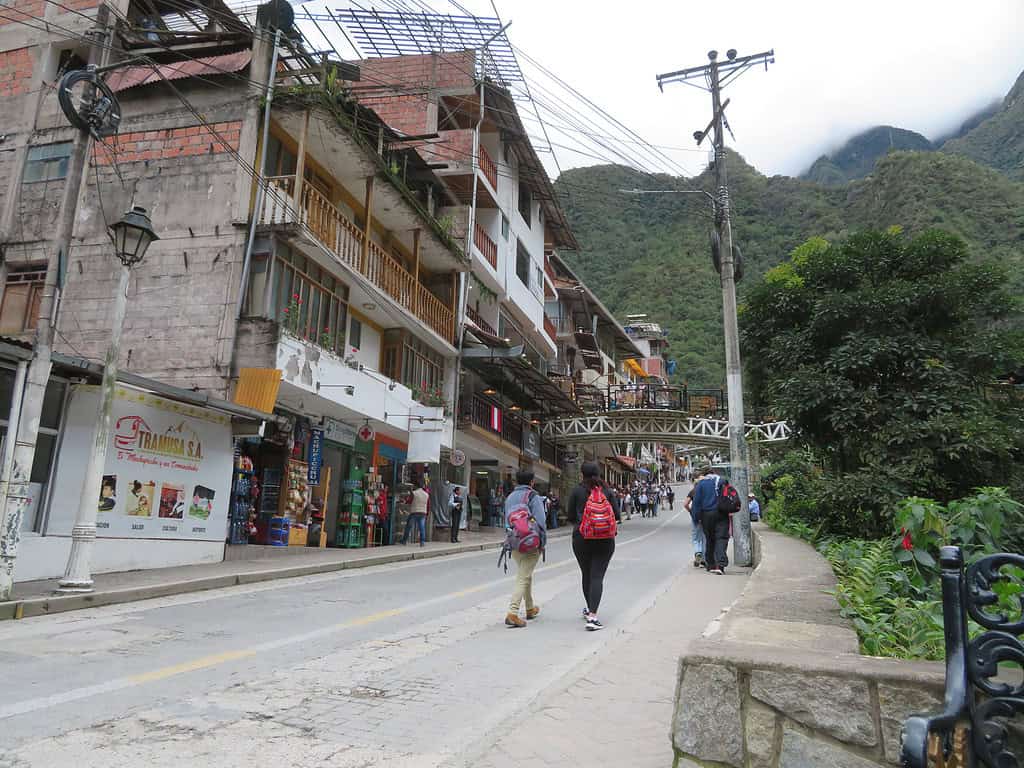
My wheelchair was stored in storage while I rode the bus and visited Machu Picchu. It went smoothly and there were no issues.
Unfortunately, neither the train nor the bus are wheelchair accessible. The only way to board them was to be carried on. Luckily, the team at Accessible Travel Peru has experience with this and I felt safe the entire time.
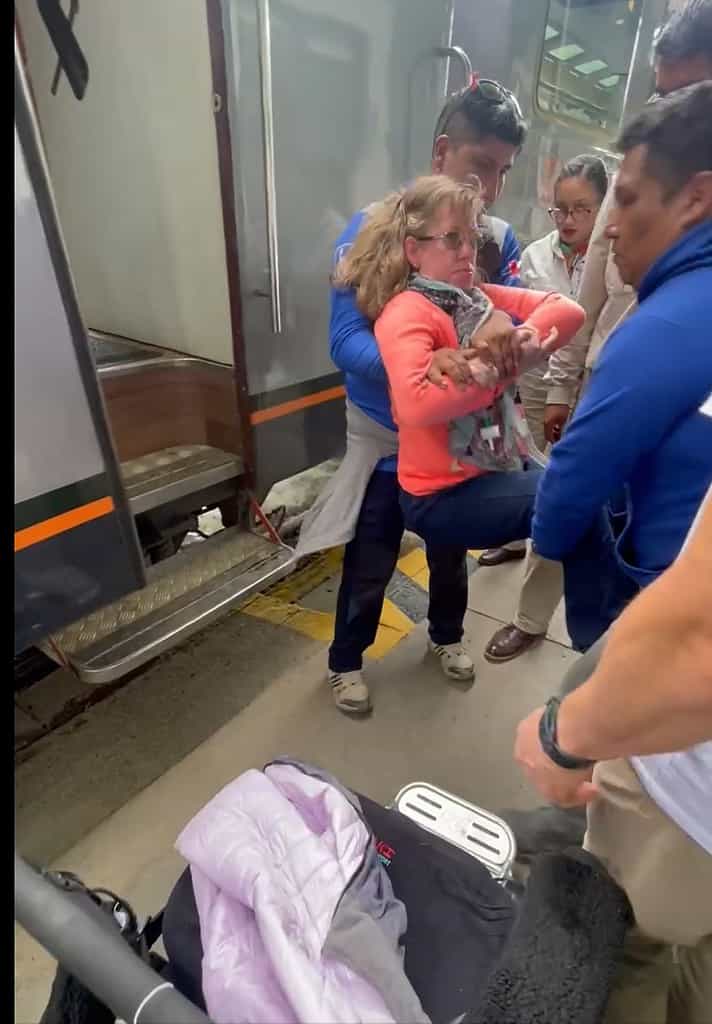
Please be aware that if you plan to visit Machu Picchu on your own, you will need to book tickets far in advance. They are now limiting the number of visitors to Machu Picchu each day to help preserve this ancient site.
At Machu Picchu
Once at Machu Picchu, we again used the adapted wheelchairs to traverse the uneven terrain and stairs. Along the way, we stopped at a few different viewpoints and even were able to enter one of the buildings.
Needless to say, it was a very emotional day for everyone. I never imagined I’d be able to visit Machu Picchu in a wheelchair and to finally achieve that goal was a bit overwhelming. I would have never been able to do it without the help of Accessible Travel Peru.
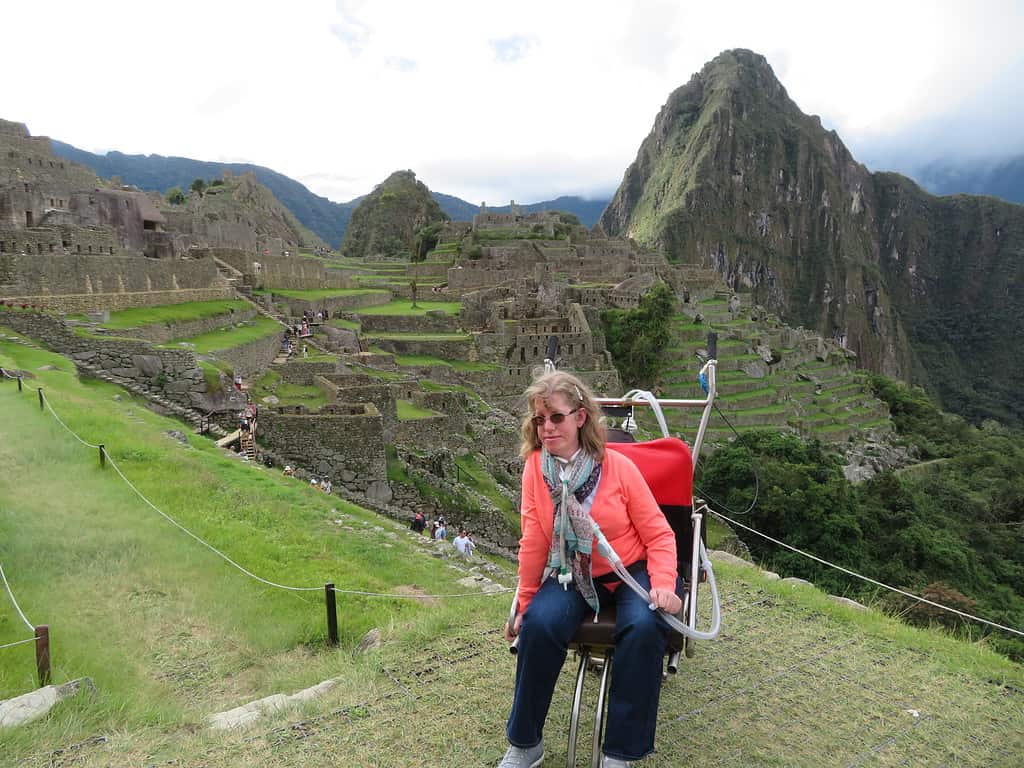
Day 7: Drive to Puno
While there is a train that will take you from Cusco to Puno, the schedule didn’t align for the day we needed to travel. As a result, the guide drove us. It’s a scenic travel day that will take up most of your day.
There were two stops along the way. One at a restaurant for a buffet lunch, and the other at a scenic viewpoint. The viewpoint was the highest elevation we’d be at for the day and a stop allowed us some time to acclimate. The views were also incredible.
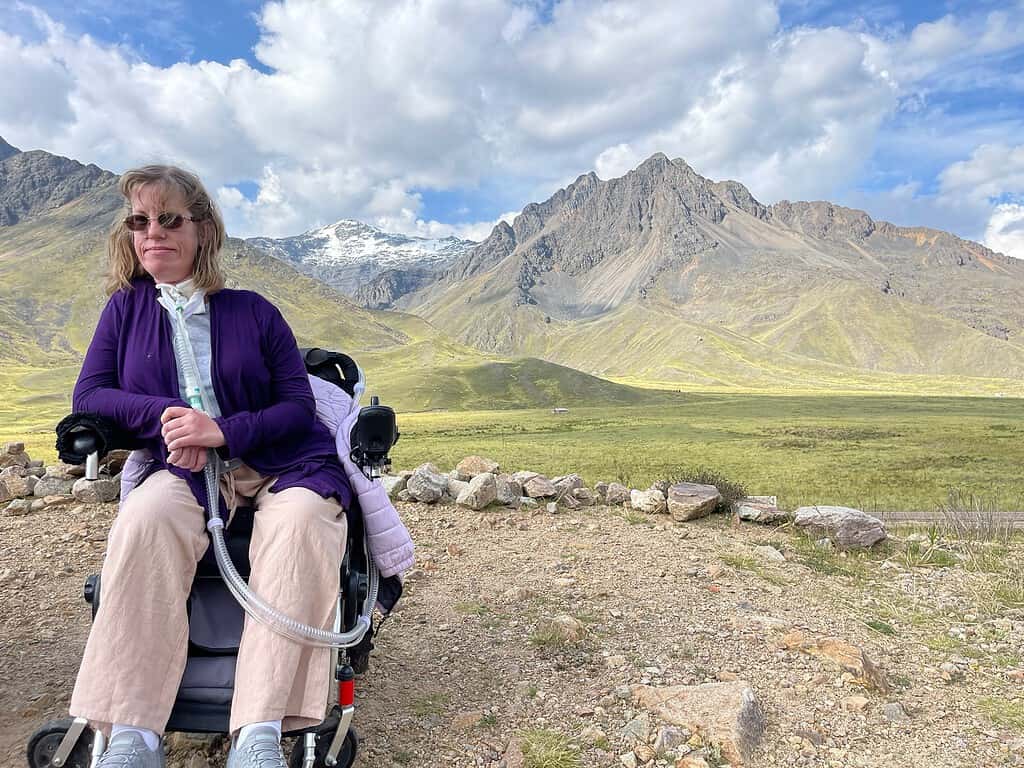
Accessible Travel Peru uses a van that has been adapted so I was able to stay in my wheelchair during the journey.
Day 8: Lake Titicaca
On the last full day in Peru, I took a boat ride on the world’s highest navigational lake, Lake Titicaca. The boat made two stops, one at the floating villages of Uros and the other at the island of Tequile.
Unfortunately, the boat is not accessible. Stairs are required to reach where the boat is docked and there is a large gap with a narrow door to enter the boat.
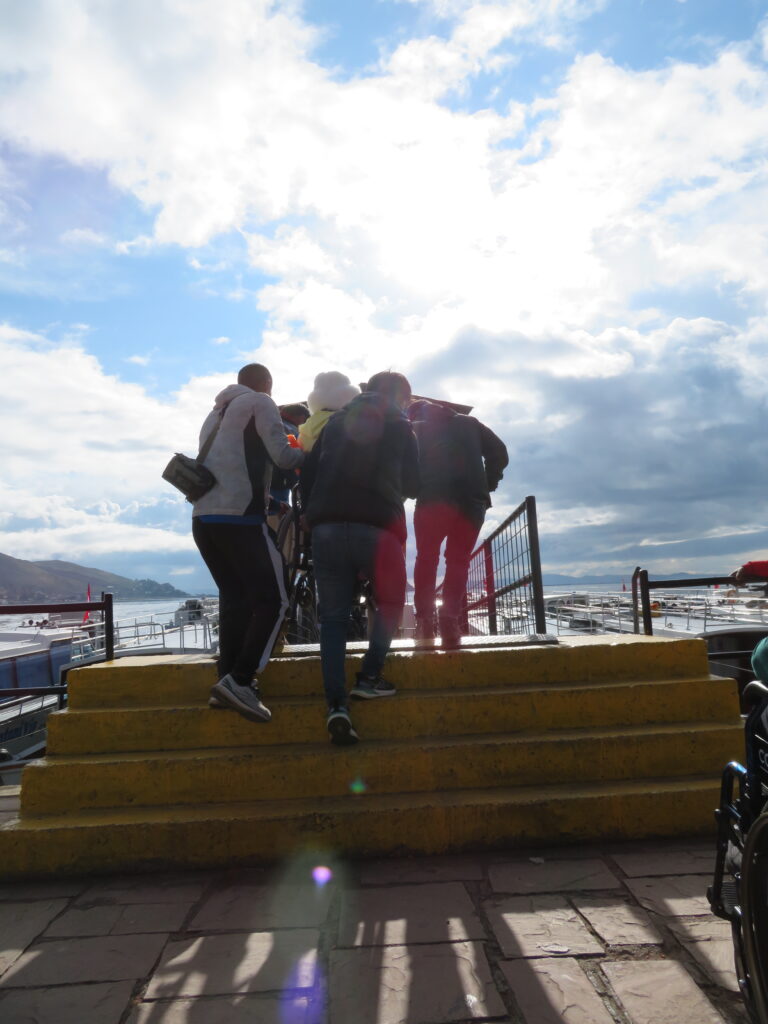
In order to board, the helpers from Accessible Travel Peru lifted me in my wheelchair up the stairs and then lifted me (not in my wheelchair) over the gap to board the boat and to my seat.
Additionally, they brought along the one-wheeled adapted wheelchairs to help us get around the islands which had uneven and sometimes steep surfaces.
Uros
The floating village of Uros is a collection of floating islands made from reeds and is one of the last of its kind. Visitors are welcomed into the community to learn about the local way of life, how the islands are made, and of course to purchase locally-made goods.
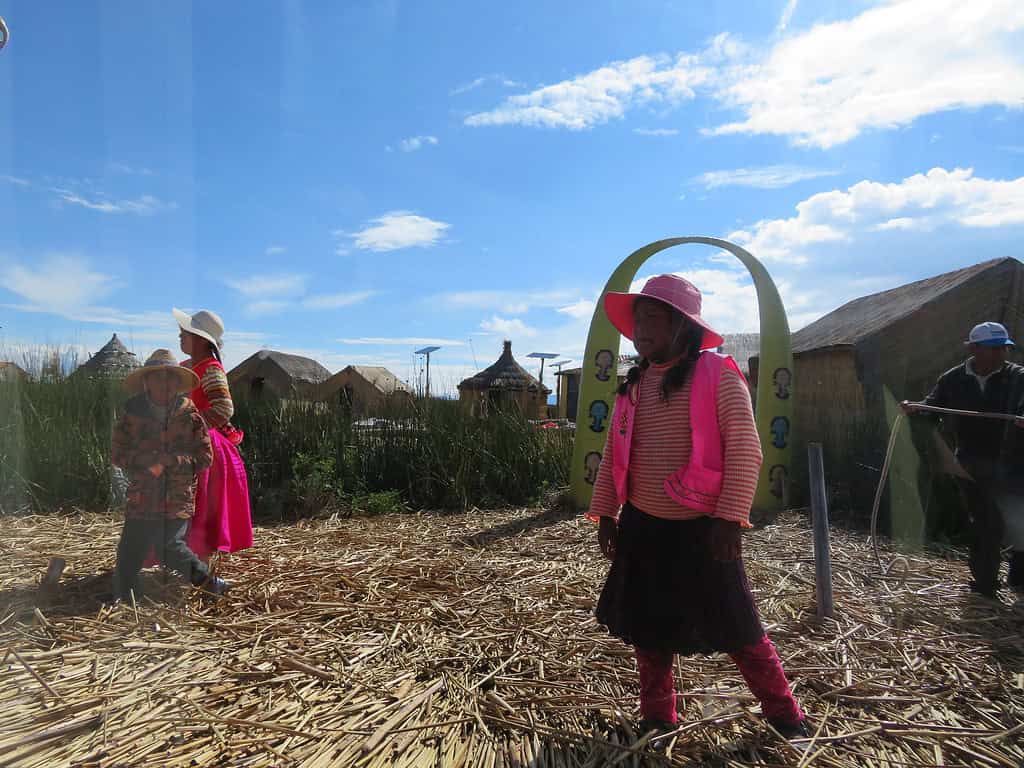
The head of the community directs the boats to different islands so that the opportunity to sell goods is evenly distributed and no one family gets all of the tourism.
During my time in Uros, I visited with a local family, saw their incredible weaving, and learned much more about the community than what is ever shown on television.
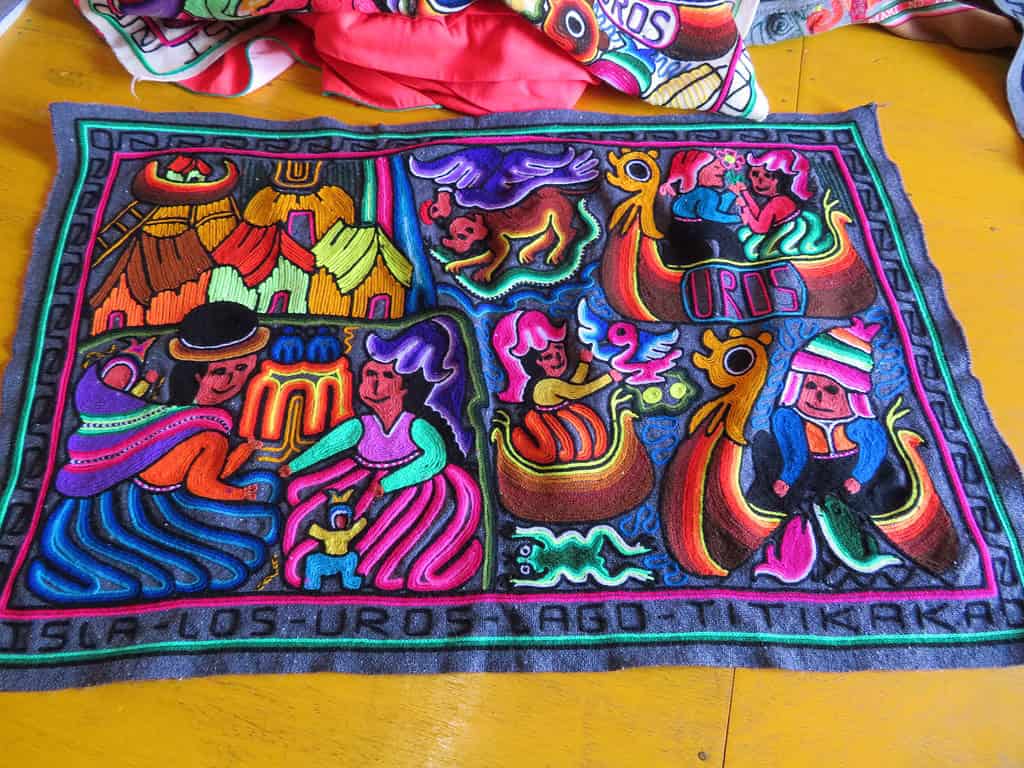
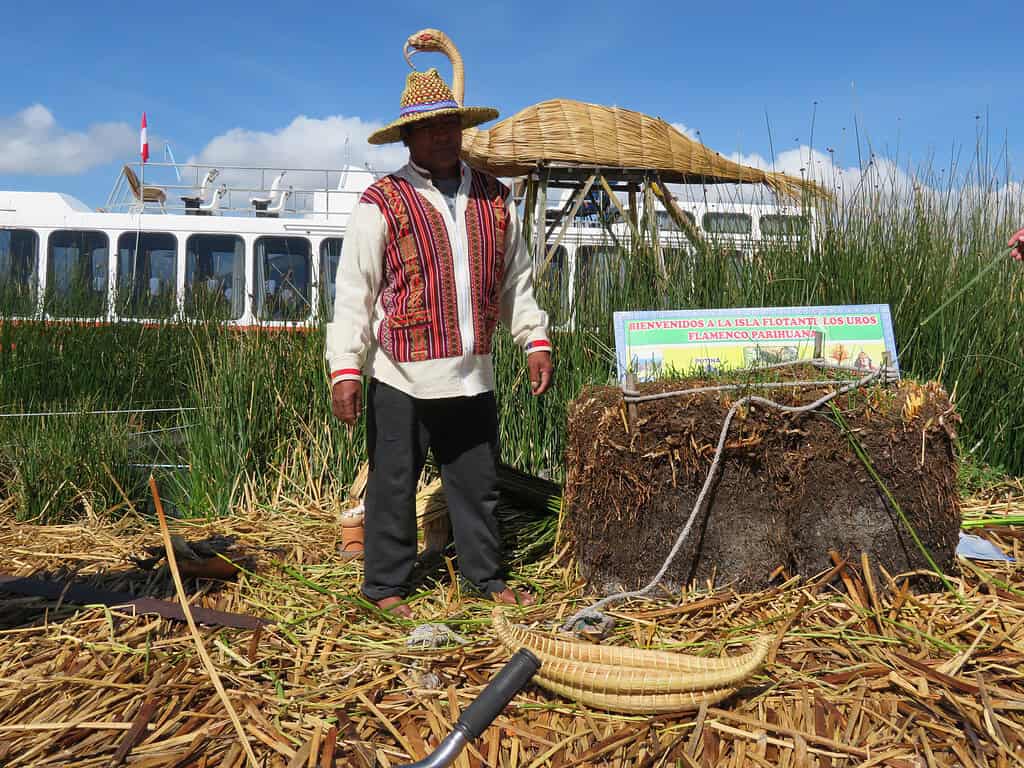
While the houses themselves were not accessible to wheelchair users, it was still nice to see the outside of them and learn more about life on the islands.
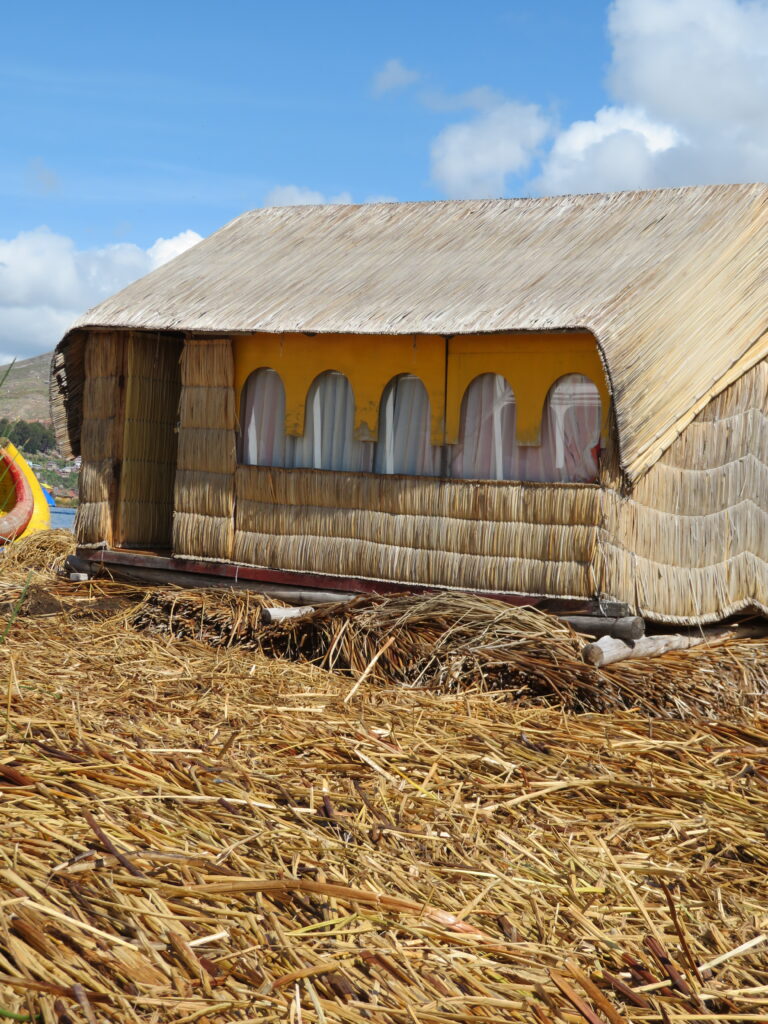
I also got to ride in one of the reed boats. Originally, these were the boats where people lived on the lake to escape Incan rule. Now, they are somewhat commercialized and used to entertain tourists. However, I still enjoyed the unique experience.
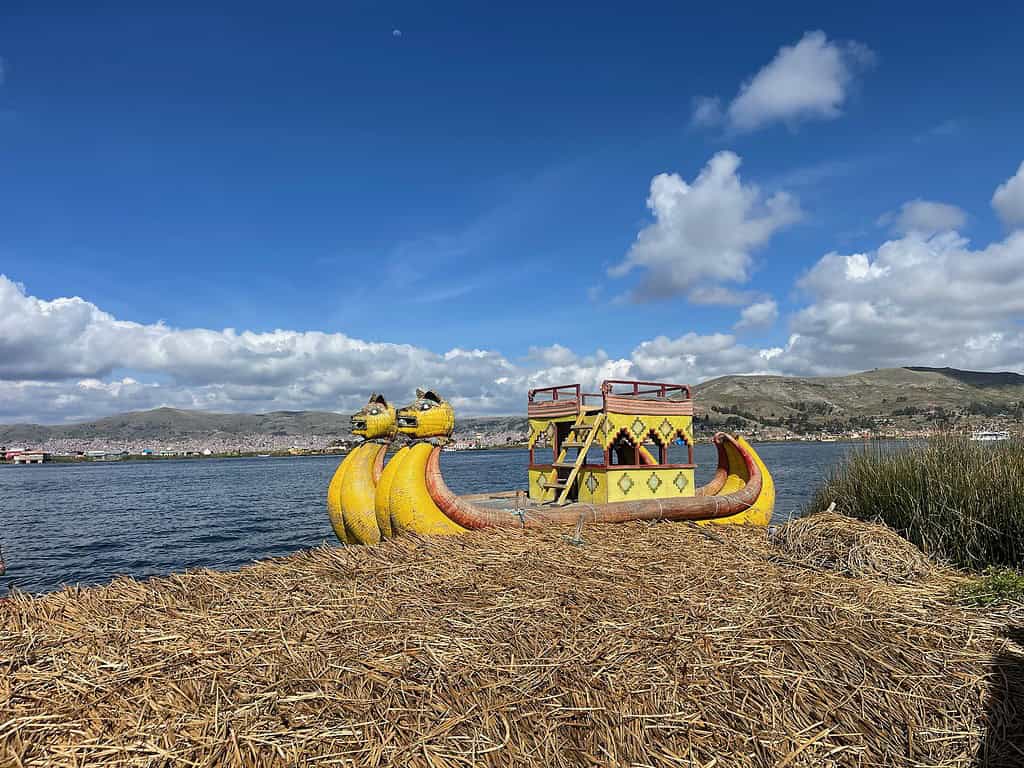

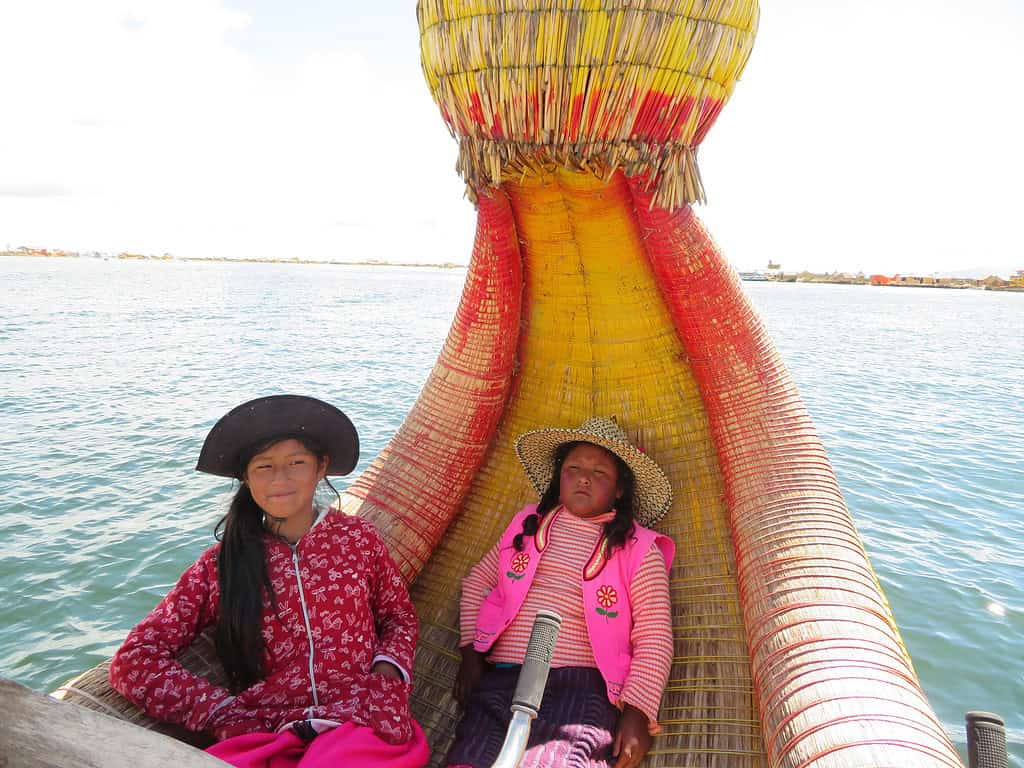
Tequile
Tequile is another island on Lake Titicaca where another community resides.
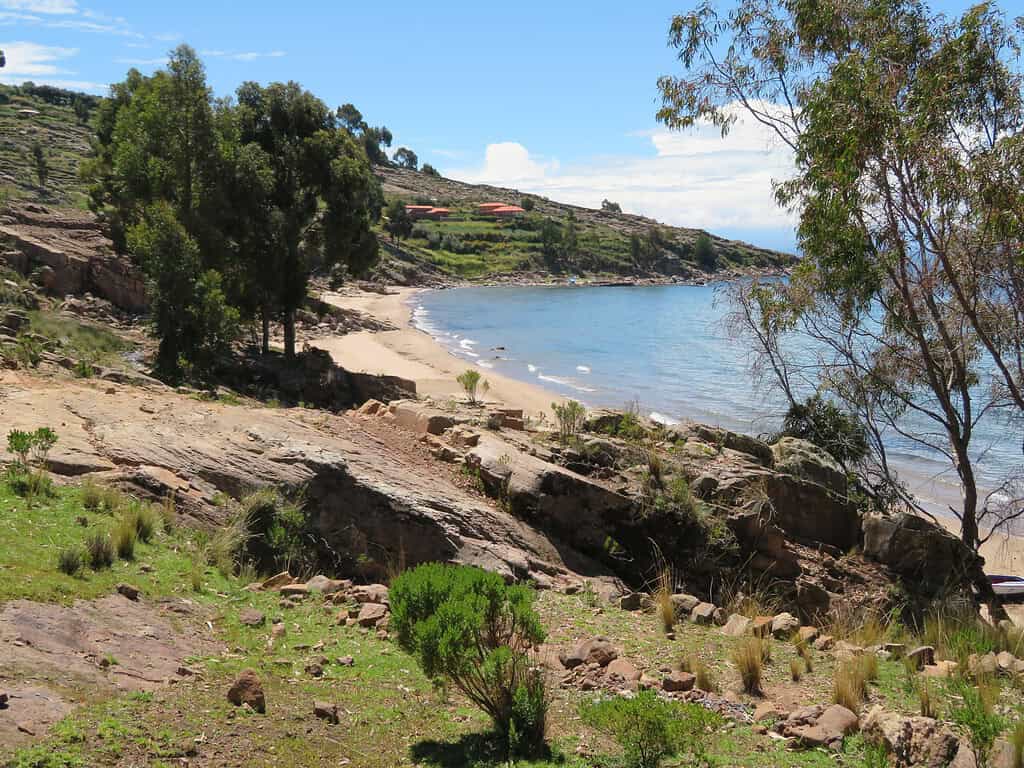
Unlike in other areas, here, the men do the weaving and they are not allowed to marry until they master this skill. Additionally, men and women must live together for 2-3 years before marrying each other to see if they are a good fit because divorce is not an option.
Upon arriving on the island, we had to navigate up steep paved paths to where the people gathered and welcomed us with a song and dance.
There was also an opportunity to purchase locally made goods. However, one of the most interesting things was when a woman demonstrated how leaves are used as soap. They are crushed and made into a paste before it is then added to water.
It’s incredible how plants can be used in so many different ways and how the knowledge is passed on from generation to generation.
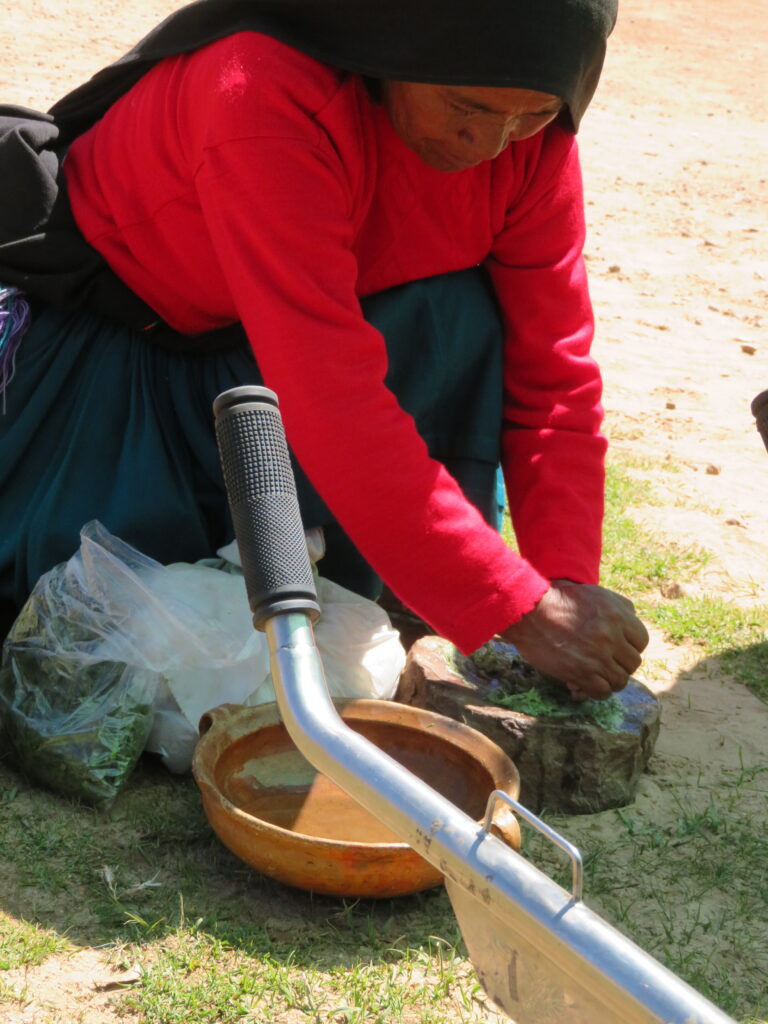
After visiting with the community, we were then taken to a home for lunch. The view while we ate was amazing and I couldn’t ask for anything better. It reminded me a little of the Amalfi Coast in Italy.
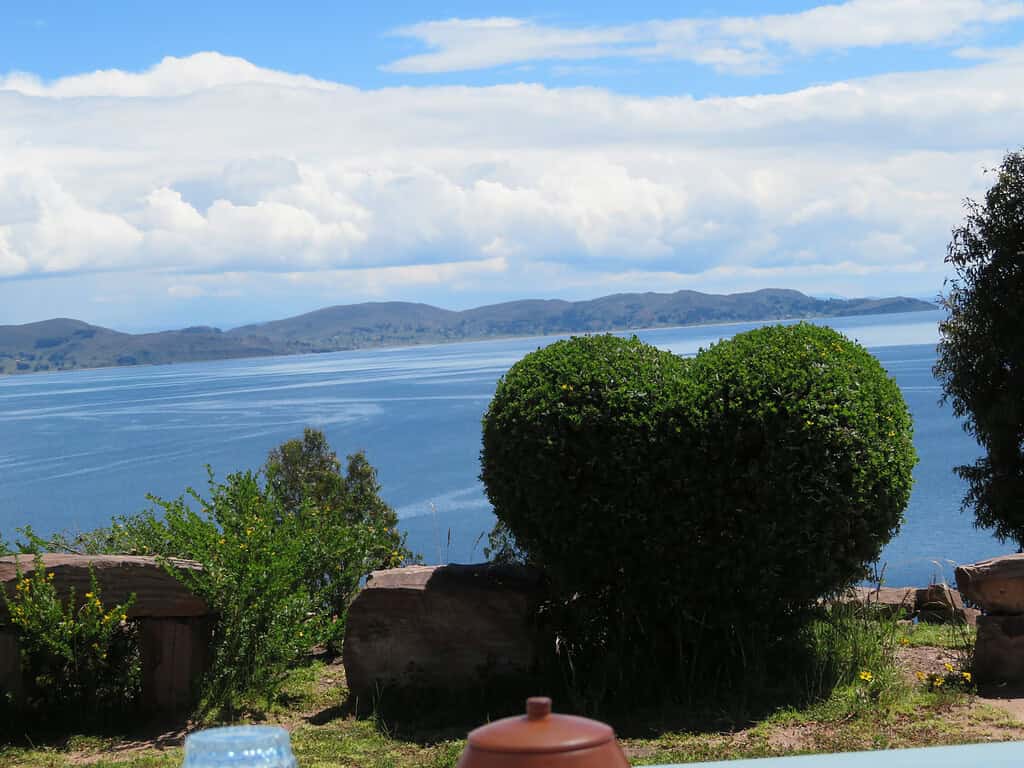
Our guide then shared a little more about local life before we headed back to the boat. It was sad to say goodbye to what was truly a wonderful day.
After such an amazing trip, you have the option to fly home from Puno or back to Lima to catch your international flight home. If flying home today, make sure to schedule an evening flight.
If You Have More Time
If you have slightly more time, 10 days in Peru for example, you could spend another day in Lima and an additional day in Cusco to explore more of the area and Incan ruins. However, trying to add another city to an already busy itinerary is not advised.
Additionally, if you wanted to combine a trip to Peru with another country or bucket list destination, you could easily add on Ecuador, a trip to Iguazu Falls, a cruise to Antarctica, or (if you have unlimited time) trips to all of the above. In fact, the cost of a cruise to Antarctica maybe even more affordable than you think.

Wheelchair Accessible Hotels in Peru
Ibis Miraflores
The Ibis Miraflores had the best accessible bathroom layout and was the closest to accessible hotels you would find in the United States. There was room to maneuver my wheelchair within the room and the bathroom had grab bars and a roll-in shower with a fold-down seat.
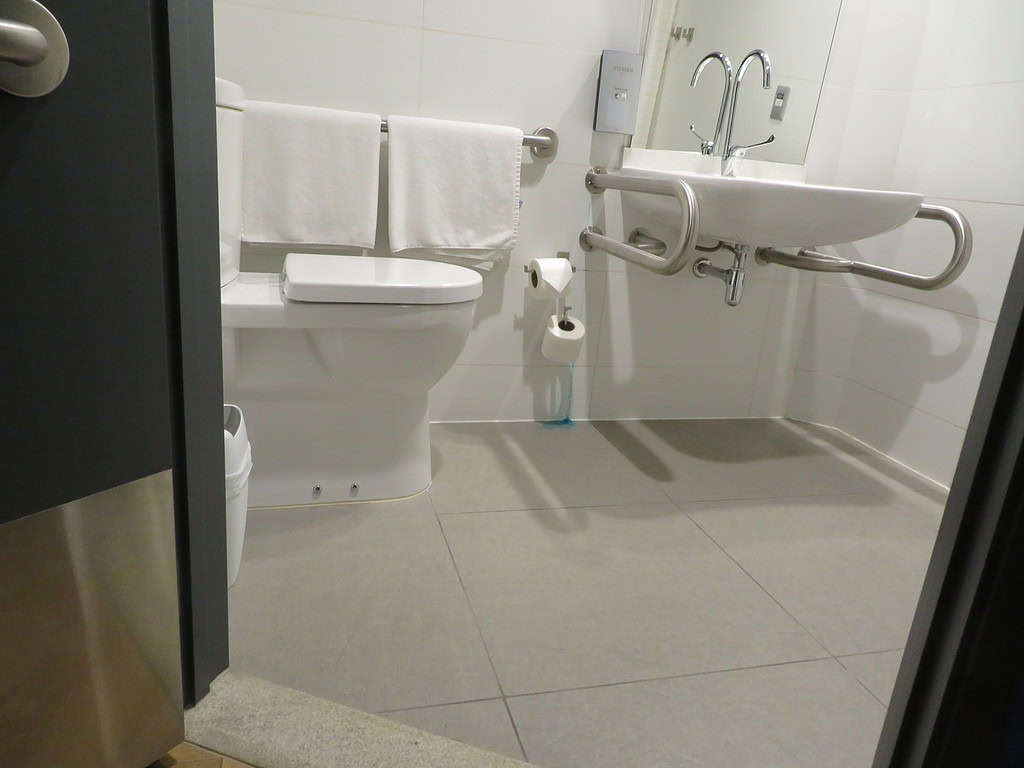
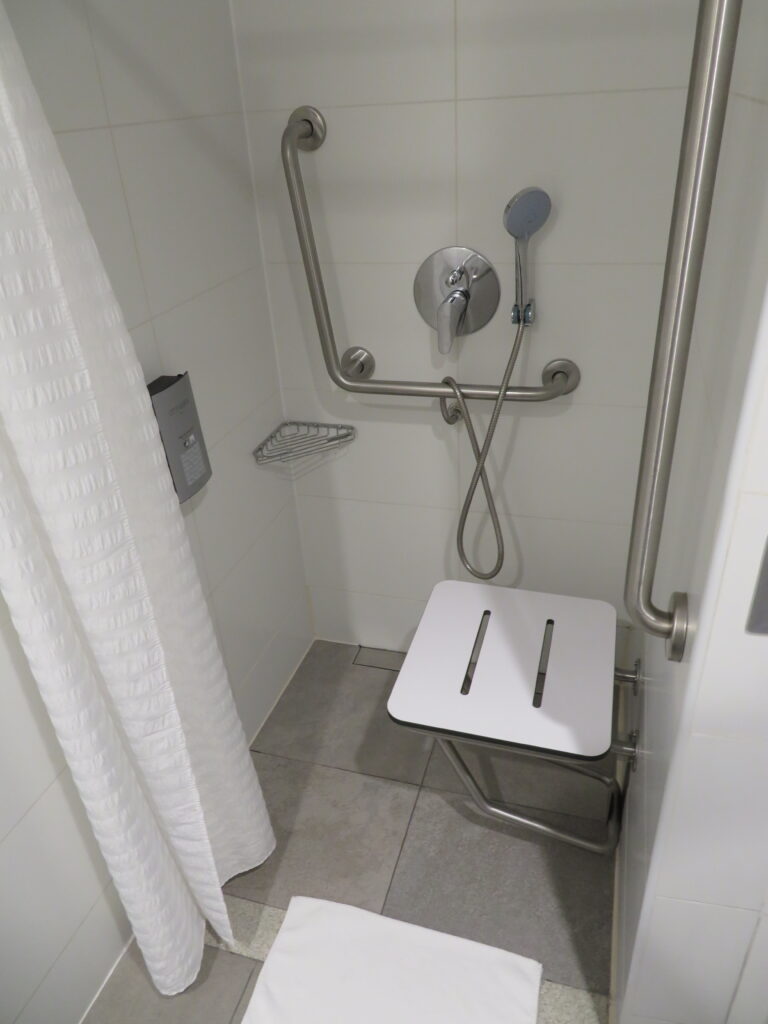
The staff was friendly and helpful. An onsite restaurant had breakfast included in the price of the room and offered a limited selection for lunch and dinner. However, there were plenty of restaurants around the hotel if you preferred to eat out.
➡️ Check pricing and availability for your travel dates by clicking here.
XIMA Cusco
The hotel in Cusco offered spacious rooms and an accessible bathroom with a roll-in shower. While there were grab bars, they were not always in the best areas to make them helpful or useful.
Furthermore, due to the layout, transfers were a little challenging. The toilet was also very low. The hotel provided a portable shower chair for me to use.
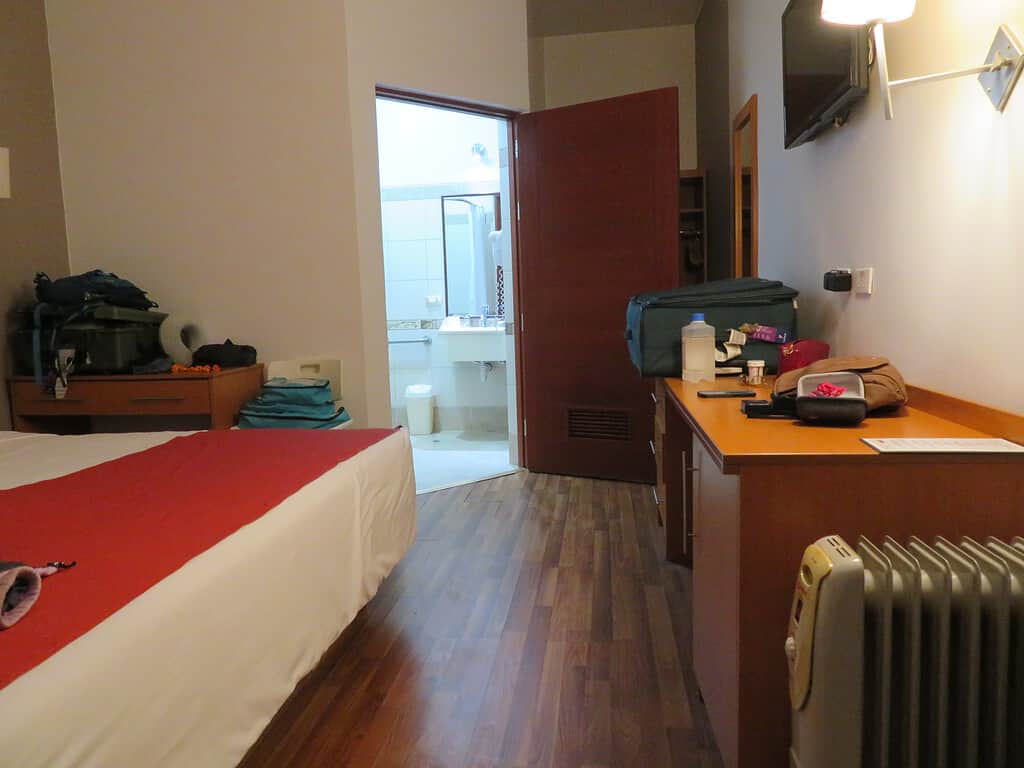
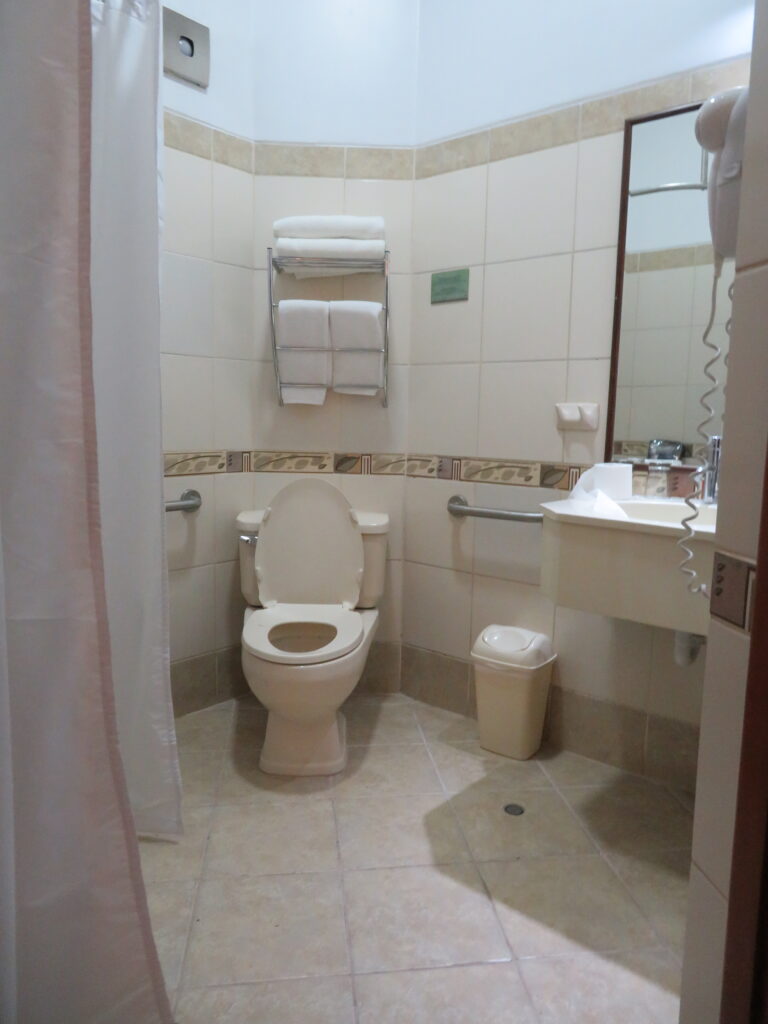
However, the hotel had a lovely courtyard where you could relax as well as an onsite restaurant. The food served was delicious and breakfast was included.
The hotel was also located just a short walk/roll away from the main square. It was very convenient for exploring the city.
➡️ Check pricing and availability for your travel dates by clicking here.
XIMA Hotel Titicaca
Accessible hotel rooms are extremely limited in Puno and even this hotel only had one available. However, the staff was wonderful and wanted feedback on how they could improve both the rooms and the hotel in general which was refreshing to see.
My room was spacious and the bathroom worked for the most part. There was one grab bar near the toilet and a roll-in shower that had no seat. Staff provided me with a wooden chair to use but this may not work for everyone.
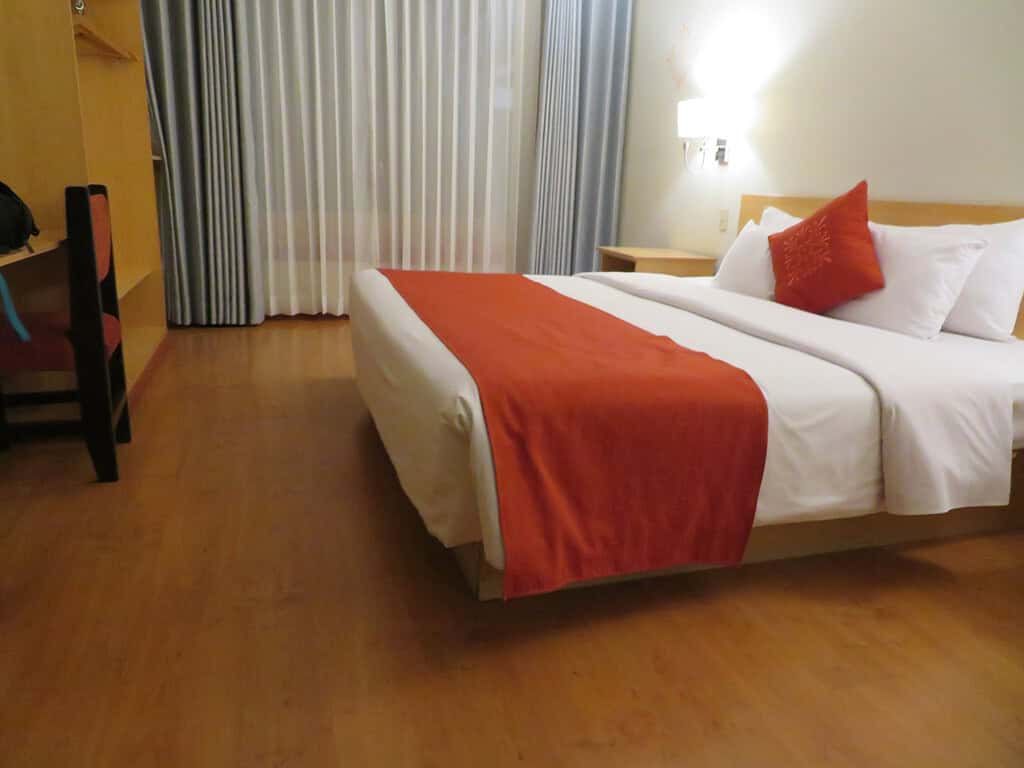
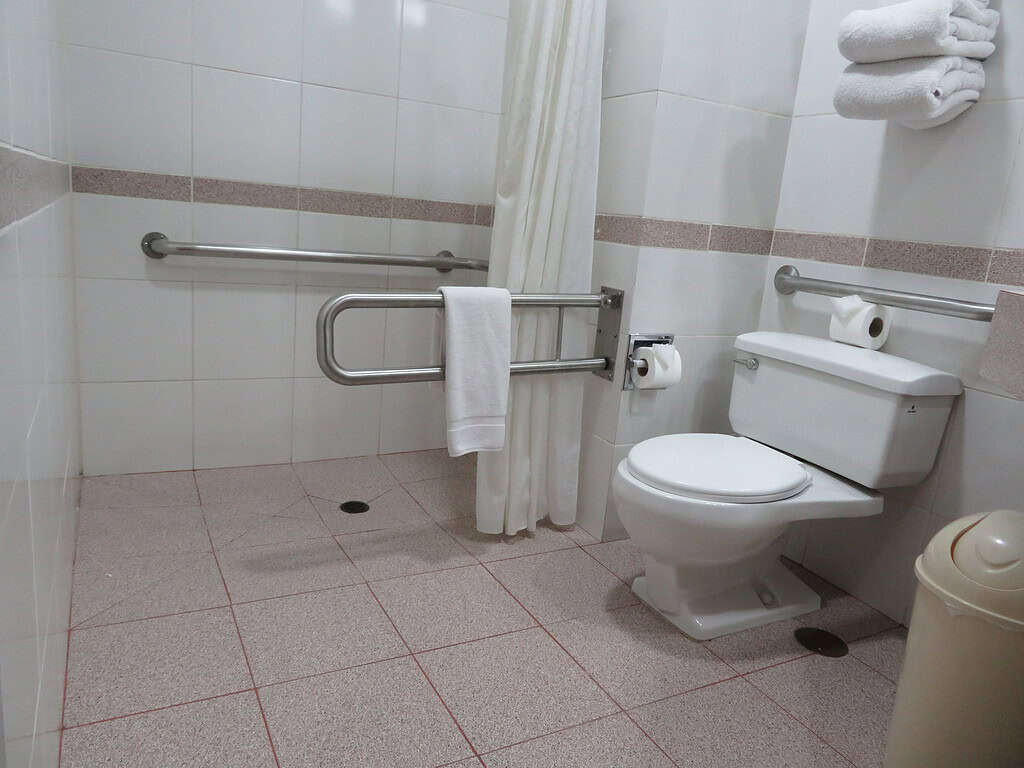
The onsite restaurant was nice and breakfast was included. I did eat dinner here as well as the city of Puno is not very accessible in general and often lacked curb cuts. The food was good and reasonably priced.
➡️ Check prices and availability for your travel dates by clicking here.
When to Go to Peru
The dry season runs from May to October and will be the most busiest time to travel to Peru as more people will have time off of work or be out of school. For a less crowded experience, consider visiting during the rainy season.
I traveled to Peru in late March/early April when the weather was in transition from the rainy to dry season. The benefits were fewer crowds, lush and green scenery, and pleasant weather. While it did rain a little, no days were total washouts with showers only lasting a couple of hours.
Additionally, it didn’t rain every day. In fact, there was only one day where we encountered rain and most other days were just overcast. We were even lucky enough to have some sunny days.
What to Pack for a Trip to Peru
Preparing for a trip to Peru will require packing the right things so that you are comfortable no matter the weather. I recommend packing layers, a rain poncho, bug spray, sunscreen, and comfortable shoes.
Of course, deciding on specific items will depend on what you plan to do during your trip and when you will be traveling. However, for people with mobility problems, I have created a detailed Peru packing list to help make sure you don’t forget anything. So, make sure to check out that post!
Peru Trip FAQs
Is 8 Days in Peru Enough Time?
I will admit that my 8 days in Peru were busy! While I got to see many of the most popular highlights, there were still things I missed (such as the Nazca Lines and Colca Canyon). If you have limited time to travel, it’s better to see some of the sights than none of them.
However, be aware that there will be more to see and do in Peru than your itinerary allows for. Honestly, you could probably spend 3 weeks in Peru and still want to return.
For a more relaxed pace trip, I’d recommend spending two weeks in Peru if possible. This will allow you time to adjust to the altitude changes and see a little more of this beautiful country.
Is the Water Safe to Drink in Peru?
No, the water is not safe to drink in Peru. You’ll even see locals opting for bottled water. My doctor advised that Typhoid can be a problem and drinking the water (or even brushing your teeth with it) can make you sick.
That’s why you’ll see many (but not all) hotels have a water purifier and filtration system. However, when in doubt, spend a couple of Sole (the local currency) to get bottled water. Alternatively, if you’re worried about being in a more remote location, you could also opt to bring a personal filtration system like a Life Straw to filter the water.
Likewise, be mindful/wary of eating food that is washed in the water (such as fruit and fruit juice) as well as ice.
Will I Get Altitude Sickness?
People react to altitude in different ways so it’s impossible to predict whether or not you will feel its effects. Consult with your doctor about any concerns you may have regarding your specific medical history.
Also, familiarize yourself with the signs and symptoms of altitude sickness so you can intervene sooner if you start to see them in yourself or one of your travel companions.
Many hotels offer emergency oxygen as well as coca tea. Furthermore, you’ll see coca leaves being sold by many roadside vendors. This is what the locals use to combat the effects of altitude.
Travel Tip: Do NOT bring any coca leaves back to the United States as this is a felony. Coca leaves are the primary ingredient to Cocaine. While it’s legal to eat the leaves in Peru, simply having them on your person or in your luggage and going into another country can be a crime.
Should I Tip in Peru?
Unlike the United States, tipping in Peru is not common or expected. However, there are a couple of instances where you may want to consider providing a tip, like when you have a private guide.
Similarly, in some restaurants, you may want to round up the bill. Tipping an extra 10-15% is not the general practice. Likewise, check your bill as sometimes establishments will automatically add a service charge or fee and in this case, you wouldn’t provide a tip.
Is Peru Safe?
Like most destinations, it’s important to be aware of your surroundings as theft is the most common crime. Leave your valuables at home (like expensive jewelry) and mind your purse/wallet in crowded or busy areas.
However, I never felt unsafe during my time in Peru. Although being in a group of people certainly helped deter any would-be thieves.
Final Thoughts on This 8 Day Peru Itinerary
While this 8 Day Peru itinerary is fairly fast-paced and will require a sense of adventure for those with mobility problems, it is one of my favorite trips. Not only for the things I got to experience but because I also shared it with some of my readers as the first wheelchair-accessible small group tour I organized. I have no doubt that should you embark on a trip like this to Peru you will have as much fun as I did.
